Interview: Christopher Hector, pix Ros Neave
Carl Hester is not only generous with his time, he is a delight to interview. His replies are always fresh, intelligent, and, lots of the time, very funny. So it was as we sat in the afternoon sunshine at the QSEC indoor during a break in his master class….
It has been interesting seeing you do all this young horse stuff, because I always had the feeling that you were a little like Georg Theodorescu, who felt that competition began at Prix St Georges level, and it was a bit unbecoming for a professional to compete any lower than that…
“I still feel like that personally as a rider, because I don’t need to do it. I’m not a one-horse owner. As I’ve said to you over the last few years Chris, my pleasure is in training, not competing. I’ve got Charlotte to go out and do all the young horse things, which she’s been doing. It’s kind of evolved a bit more that way, in the past, the pre-Valegro days, the kind of horses I had, they weren’t Young Horse winners at all. They were just not the type, but they went on to be Grand Prix performers. For that reason, rather than take them out and get no-where, and be unsuccessful because they weren’t liked as young horses, I’d keep training them until I got to a level where I could go out and be competitive.”
But I suspect that it is still a bit that way at the Grand Prix level. Okay we are getting a few horses like Dante Weltino that are that beautiful elegant young horse type – but I would think that more of our GP horses are in the mould of Wolfram Wittig’s Breitlings, chunky, strong, willing…
“I agree with you, but it is good that some of these young horses are going on, otherwise the Young Horse thing becomes a sport on its own, which I thought it was in danger of becoming…”
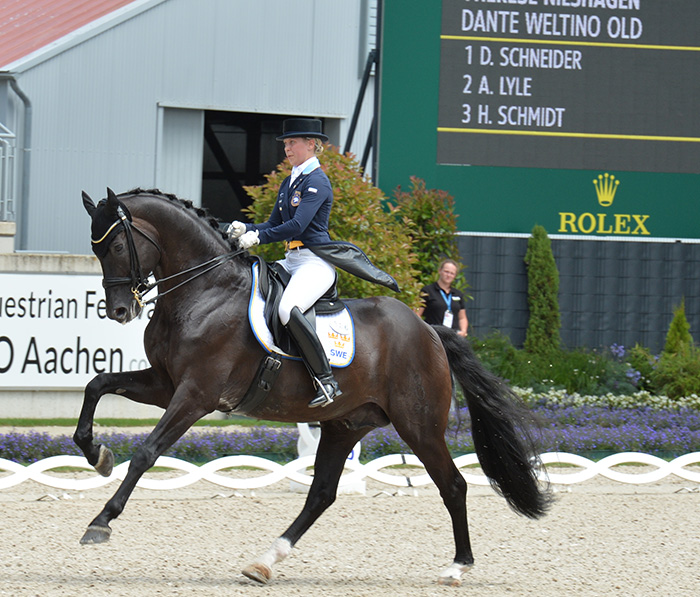
Dante Weltino, young horse star and now successful Grand Prix performer
You don’t think it has?
“I think it did, a few years ago, I think everyone felt that it had. Listening to the judges they say it is progressing, that they are being judged with a view to Grand Prix. I haven’t been to a Young Horse championship in over five years. It does not interest me at all. It’s just interesting listening to the judges, how suddenly we tumbled into a pit and were confronted with over-moving, over-bred young horses, and now that is changing. Working with Peter Holler, who judges a lot of young horse classes, here at Brisbane, the first thing I said to him was what is the most important thing the movement or the temperament and his emphasis was on a natural moving horse not an over-produced one.”
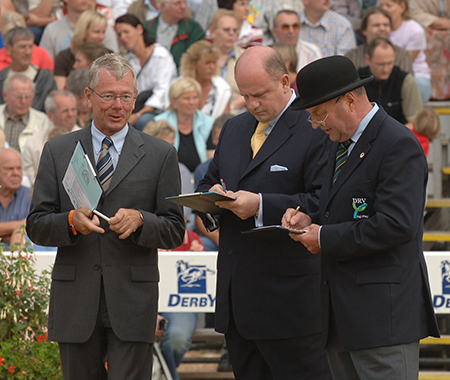
Peter Holler (on left) part of the Judging Commission at the greatest young horse show of all, the Bundeschampionat
But this is the schizophrenia of our sport, we have judges’ clinics where they talk about all this good natural stuff, then they go out and judge entirely differently at Grand Prix – and the same thing at Young Horse level. There was a horse at the last World Championships that got a ten for its trot, and it was classic ‘pissage’ – I said to the judge, I always thought a very hovering trot was an evasion, and yet you gave a ten…
“I need to see it for myself. The thing is, in England, we don’t have those big moving types, we don’t train for that. The emphasis is not so much on the Young Horse classes. They are just nice classes to take your horse out to for a bit of education. And that is what we use them for. Charlotte said, let’s go to the World Young Horse championship, and I said, no, that’s not our focus. You’ve got to think about what you are turning the horses into, I don’t want them turned into those sort of horses at 4, 5, 6.”
Because it is counter productive to producing at Grand Prix horse…
“I think you are right because there are not enough horses at the top that have come through that system, and you can’t say that there haven’t been good riders on those horses. And yet, so few of them get to the top. I would presume that every horse in our yard will make Grand Prix. Whether they will be top Grand Prix horses, I’m not saying. We haven’t got eighteen horses that will win eighteen gold medals but we have eighteen horses and there is no reason why all eighteen couldn’t do a Grand Prix, provided they stay sound, nothing has an awful colic and dies, or something, they should be able to do a Grand Prix test. But they aren’t great big moving horses, they are horses that, with help, can learn to do everything.”
Do you think that is your strength – watching you teach today and the way you were looking at each individual horse and bringing out their potential…
“I’d like to be able to think I can do that, but I only feel I can do that because of the number of horses we’ve trained at home over the years. I’ve had the ones that I thought I should give up on when they were six, and then I realised that when you don’t want them, nobody else wants them either. The good thing is when you realise that, you start to get stuck in…”
And end up going to the Olympics on it…
“Exactly. Nip Tuck is the classic case. If we had a yard of world young horse champions, great big movers, I can’t believe they would all go to Grand Prix because the reactions aren’t quick enough because the movement is too big.”
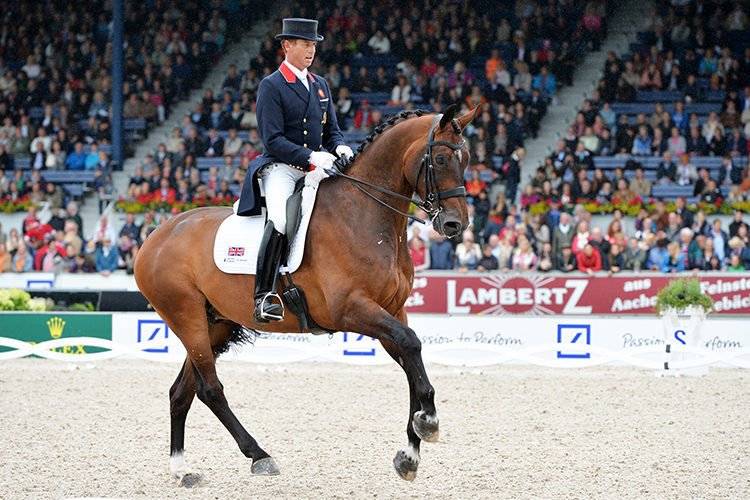
I love Nip Tuck, don’t get me wrong, but you must have had a dozen horses that looked more promising for GP than him, and never went half as far as him – is that the brain bit?
“That’s the brain bit and it’s my education, I suppose. Now I’m older, being happy not to win, I suppose that’s number one. That’s calmed me down a lot over the years, being happy not to win the class, but happy with the horse being a winner for me, that’s number one and it means that you can be happy with horses that don’t win everything.”
I don’t think that’s your riding partner’s attitude…
“Definitely not, that’s where we are so good together because we are so different. Like with Nip Tuck, she said get rid of him, and when I say I might bring him back for a World Cup, she says, what for? Why would you do that? Because I enjoy it. We are totally the opposite and that’s why we work along so well. She’s aggressive and I’m passive, in our attitudes. Somebody just said to me, how do you keep going together, we keep going together because I admire her attitude, you couldn’t not.”
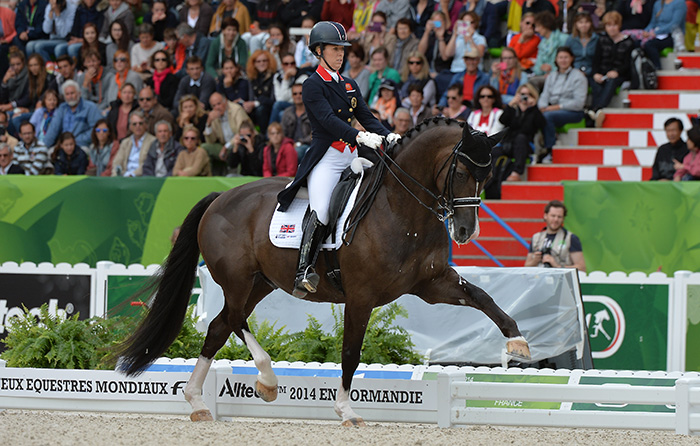
But it is kind of weird, yes she is very competitive, very aggressive but she doesn’t ride or train that way. Okay there is that amazing focus but I have never seen her look aggressive on a horse…
“That is her strength. She can go to the ring with an aura of calm. I said, oh I never get emotional at Charlotte’s performances because I find them quite safe and then you sent those pictures of me crying at Rotterdam, at the Europeans in 2011, and I thought, shit I was like that once. I do remember that now.
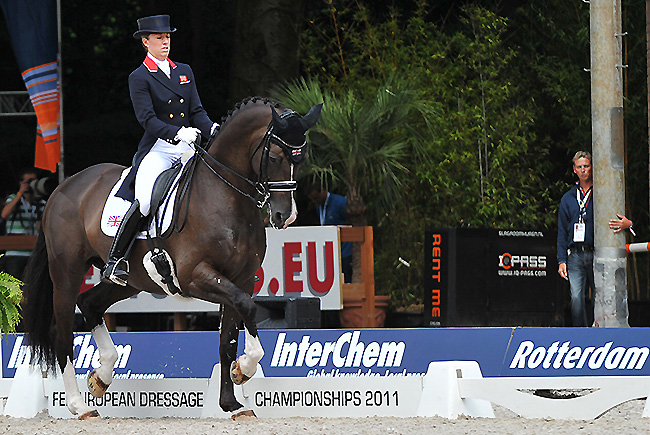
Charlotte and Valegro in 2011, see Carl at the right clutching the light pole at the entrance to the arena, and “so in awe”. He wiped his eyes at the end of the test…
But I think it’s because I was so in awe of somebody, who’s come to me, just starting at the beginning, and here she was on my horse, and they did it like they’d done it all their lives – that’s what made me emotional. It was as special for me as it was for everybody else. But since then, I can go trotting along to the arena with her and I just know she’ll do exactly in the ring what she does at home.”
What about the two you are going to take to the WEG in Tryon – you are going to take your young horse, Delicato, what sort of personality is he?
“More timid. The thing you’ve got to keep reminding yourself is, if Nip Tuck can do that, this horse should do easily that, I mean it’s got a pair of hind legs, it’s got a big walk, a great hind leg in his trot, and a great hind leg in its canter. He’s just a bit more timid and it is just a matter of waiting for him to get a bit more going – that’s all.”
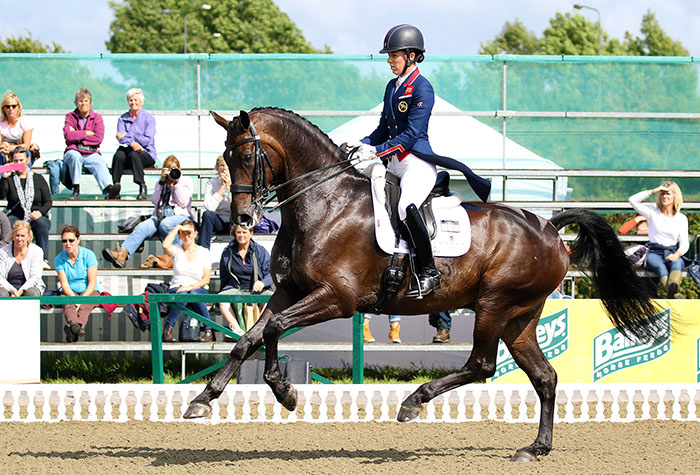
Charlotte shows off Delicato’s hind leg…
Where did you find him?
“He was bred at a stud literally three miles away from me. Charlotte and I usually buy our horses unbroken, but I was sitting at our National Championships, and because I’ve been around a while, I kind of feel that I know all the horses, and I’d never seen anything that I particularly like or hankered after, and there was a young horse championship and Delicato was third, and he went cantering past me with this hind leg like so high up! He’s Diamond Hit / Regazzoni, and he has a hind leg like Diamond Hit in canter. If you describe to someone what an extended trot look like, it is very easy to do, but when you say to someone what is an extended canter, lot’s of people think you just go flat out from one end to the other. But a horse with a good hind leg, like Cosmo, they go up first and then they cover the ground, then up again, and cover the ground, and it is because the push sends them up rather than being on the forehand all the time. So many extended canters come on the forehand whereas the horses with a hind end like my new one, pushes them up. He’s a gorgeous horse, he looks like a show horse.”
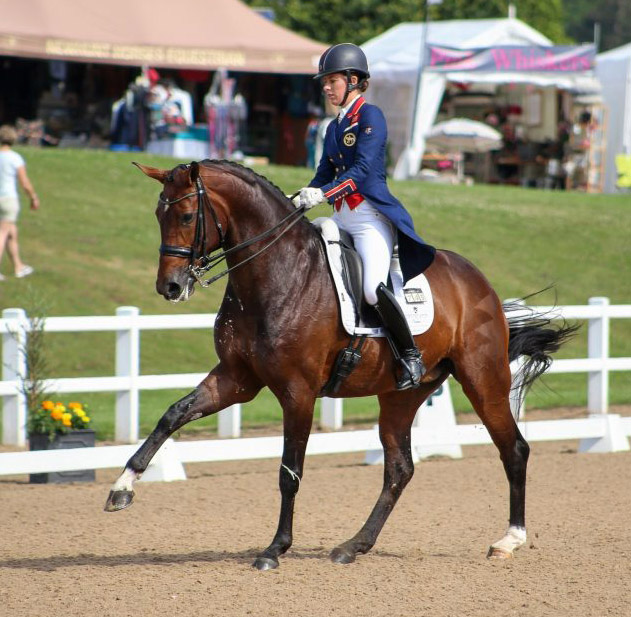
And Charlotte’s horse, Freestyle?
“That horse is just phenomenal and it’s just nine. They have both just started their careers, they’ve done under five Grand Prix. We’ve tiddled about at home this year. We are very lucky with David Trott our selector. I just said, David, two young horses, if you want them to go to the WEG, then I’m not traveling abroad. They couldn’t sustain a whole season of travel and they need educating at home. They are both very solid temperaments and they just need fittening, and they need shows at home.”
“Actually it was really nice. I hadn’t competed another horse for a while, and we went to shows down the road, like muddy fields, and it was a bloody joy for me. There was nobody there, the people that were there got the shock of their life when I turned up with my new Grand Prix horse, and I had a bloody ball because I wasn’t worried about who was watching me, or if I was going to make a mistake in my changes. I really started to enjoy it.”
How did you reach this state of beatitude where you don’t care if you win or not… you weren’t sitting under a tree meditating…
“I don’t know when it came on me, no light bulb moments, I think it probably has to do with Nip Tuck because I had to deal with the criticism, which was very often right. I had to learn to stop being possessive about my own horse, because if someone tells you your horse isn’t good, you want to give them a thump. Then I thought, get over yourself, if someone says your horse has no extended trot – guess what, they’re right. No he hasn’t, your right. Accept it. But you couldn’t say the horse wasn’t a worker, and you couldn’t say he didn’t become the best he could be. And I thought I’m going to stop worrying what other people think about because let’s face it, in dressage there are three people who win a medal, and I’m lucky enough to have been one of them, once, but I also realise how hard it is to be one of those top three. There are lots of talented riders out there, who will go to the World Games with amazing horses and they won’t get a medal. So if you get that opportunity once in your life, which I’ve had, I’m very happy to rest on that, and I’ll be very happy if it happens again, as well, but no desperation.”
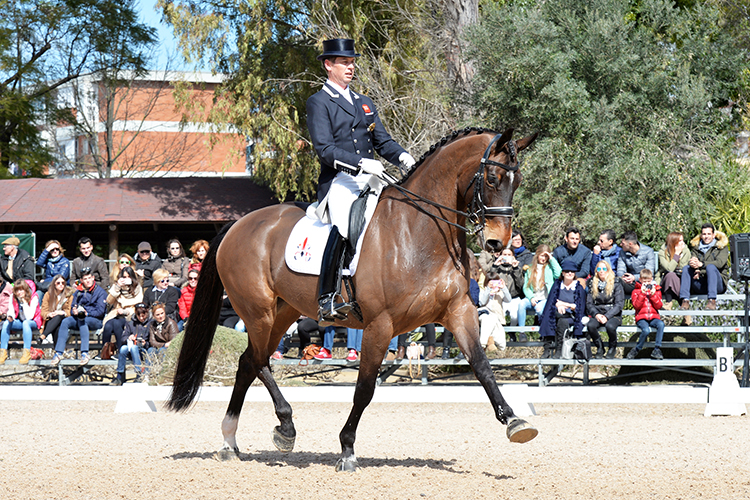
Nip Tuck – aiming for a 7.5 extended trot
The fact that Nip Tuck was able to be so successful, was that a consolidation of this new way of judging, he is like the ultimate test of whether they are to reward a horse because of the correctness of his training, because he was never ‘spectacular’ in the arena…
“That’s an interesting point because I did feel in the end, that is how I won my points. I thought I’m going to drag that 7.5 out of you, if I have to. That was what I was aiming for because to be realistic, apart from some of his canter work, the highlights like the pirouettes and changes, I had to think of everything else as a 7 or 7.5. He needs to be nicely in front of the vertical, soft hands, doing a correct bend, and why can’t they give me a 7 or 7.5? That’s what I must aim for, and as we know now looking at a 75, scores seem to have come down a bit again, we were all going 75, 80, now they have come down again.”
“I never got much over 75 with Nip Tuck, which I think is probably right, from the point of view of if you have to look at expression and power, which he didn’t particularly have, but those horses that have expression and power, often don’t have the correct frames, or the correct contact. Certainly he wasn’t a global star, but back at home I could always say to my good kids, get on Barney and feel it. Feel what a horse that wants to work, feels like. You can get on him in a snaffle and he’ll go round a Grand Prix on his own quite happily, it’s a dream feeling to have a horse like that. It might not look like a dream, but it is a dream feeling.”
Can you tell me a bit more about the ‘dip in front of the wither’ that you were talking about with some of your students…
“There were two horses that had it. The first horse I felt it was more just conformation, its neck is just not set on great. But even when it is a conformational issue, through correct stretching you could see that hole fill up as the muscle came up, then there’s no gap in the neck. The other one was when he became hollow in the back and inverted in the neck, because the rider was too heavy on his back at that point in a half halt so the horse was inverting. It’s just a really good indication, if you are on your own, which lots of people are when they ride, is that part of the neck in front of the wither, round, is it without wrinkles? It’s just a test for you to look at when you are riding, and know that if there is a gap, then the horse is not completely over the top line.”
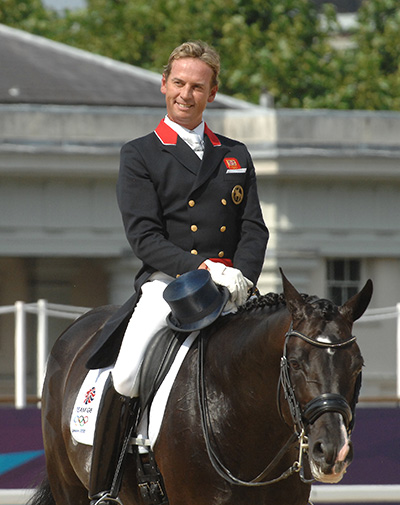
Again, it is always a pleasure to spend time with Carl, I hope you’ve also enjoyed sitting in on our conversation, next it is time for Mr Hester to get to work…
THE CARL HESTER MASTER CLASS
Sometimes my friend Carl Hester seems too good to be true. I’ve known him for over twenty years and throughout that time he has been a charming and witty companion, and the shining beacon for civilised dressage in the world. You kind of expect him to break out and do something less than perfect, but I’ve never seen a hint of it. I’d seen him ride and train lots, but never before, conduct a Master Class.
There are two sorts of Master Class. One variety is when the clinician treats the occasion as a variety act, you know the scene, lots of jokes, get the riders to show off what they do best, and always, always, at the end remark how you would like to take the horse home with you… And there are some dressage celebrities who have their routines down pat, just hand them a cheque, turn them on and off they go. It might be entertaining (at least on the first occasion) but it doesn’t do much for dressage.
The other alternative is to really train, to help the riders analyse their problem areas and offer a few solutions. I should not have been surprised when Carl chose the latter…
The occasion was helped by the quality of horses and riders in the class. This time, I don’t think Carl was being polite when he remarked at the end, that they had been the best group he’d had in a Master Class. Each and every rider could do what was asked and tried very hard to learn rather than using the occasion to show the world how brilliant they and their horses were…
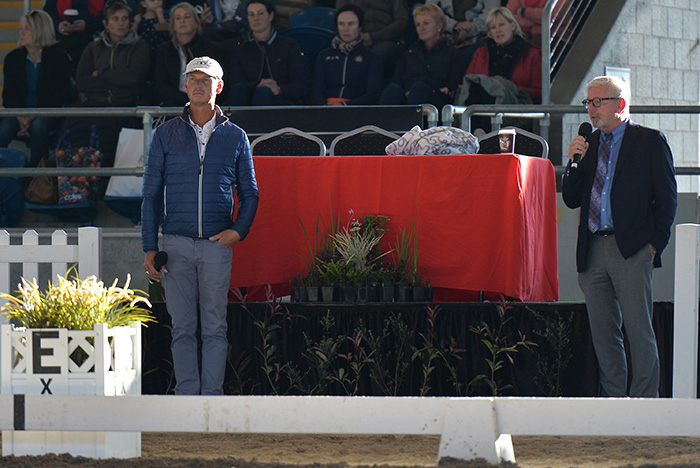
Carl really set the tone on the previous day – which was the final day of a splendid Brisbane CDI – when he, and German judge, Peter Holler, commented on the top combinations in the Young Horse classes. The tone, I am sorry to inform you dear reader, is the same old, same old, and it all starts with the Training Principles – and the first of those, relaxation:
“If they don’t have relaxation it affects their paces. Some horses can be tense and produce spectacular movement, but that’s not right either. Others go into themselves. You just have to think of the Training Scale, how the horse uses itself. Look to the head and neck, if the neck is not nodding outwards, the horse cannot be supple in its back. Nod outwards – if they nod inwards it shows they are tight in their back.”
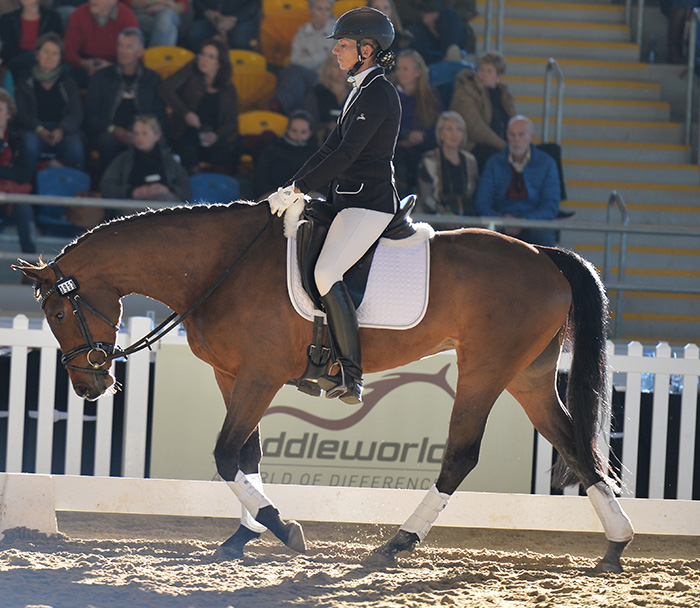
Quadriga Galicia and Marcela Adkins
Next Peter Holler…
Peter Holler stressed: “In the trot we are looking for a natural, not an extended or suspended step. Just a clear two beat and just two or three longer steps. Are they willing to go forward? Do they stay supple and rideable?”
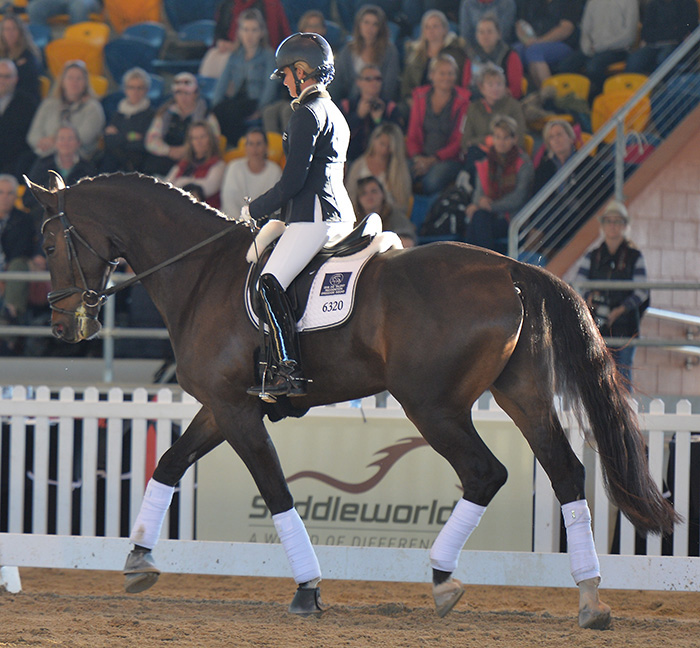
Emma Flavelle-Watts and San Fama
Fairly soon, Carl demonstrated how willing he was to use the leg yield. Pointing to the way the horses tended to lean on the rider’s inside leg – particularly when they were on their difficult rein – he suggested a few steps of leg yield to get the horse around the leg and stop them getting hollow backed in the transition.
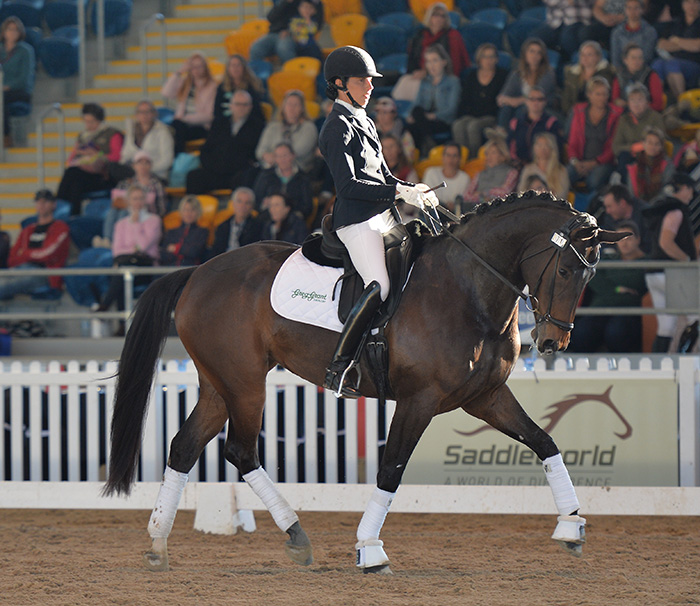
Highfields Bella Vista and Deborah Oliver
And as always, Carl was supportive of the riders. It was not the end of the world if they hadn’t got big marks at this show: “A four-year-old is a dream, and the future is in the work, it’s not always the horse you buy, it’s the work you put in. One thing we can’t tell from the outside is what it feels like. Just because it doesn’t get the scores, doesn’t mean it is not a Grand Prix horse. What you feel is important, if you can influence the horse, and it is a worker, that is very important, the scores are not the end of it all.”
When the five-year-olds entered the arena, Judge Holler emphasised that “a little mistake is okay, we are looking for potential not perfection.” And Carl took up the riff: “If we have two tests, one mistake free but with no quality, and one with quality but the horse makes mistakes, the quality should come out on top.”
And the leg yields had become a little more sophisticated now: “When you sit and ride leg yield, look at the horse’s ears. You can tell if the tips of the ears are level. If it tips its neck, you can tell it is not supple to that side and that makes the neck twist. Adjust the head, inside hand higher, lower, it is a stiffness – the horse is not being bad, but you have to dwell on it and fix the stiffness.”
In the six-year-olds, Peter Holler was a bit disappointed with the walks: “We want to see the ability to shorten, not high in the poll and very collected, just that they stay quick enough behind and in good rhythm. None of these horses would score over 8 for walk, they are not really Young Horse walks, they are Grand Prix walks, and they lose the suppleness.”
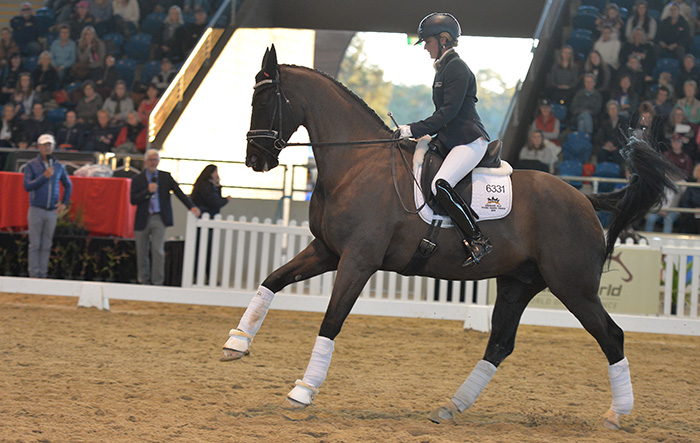
Remi Downunder and Hope Beerling show off their birthday trick
And, of course, as a sixth birthday present the horse gets a stab at the dreaded flying change. Here Carl thought part of the problem came from the rider’s legs: “The riders couldn’t get the leg on because the horses knew what is coming. Try and keep the canter smaller, and instead of surprising the horse by putting on the leg, keep the leg on. Little canter with the leg closed.”
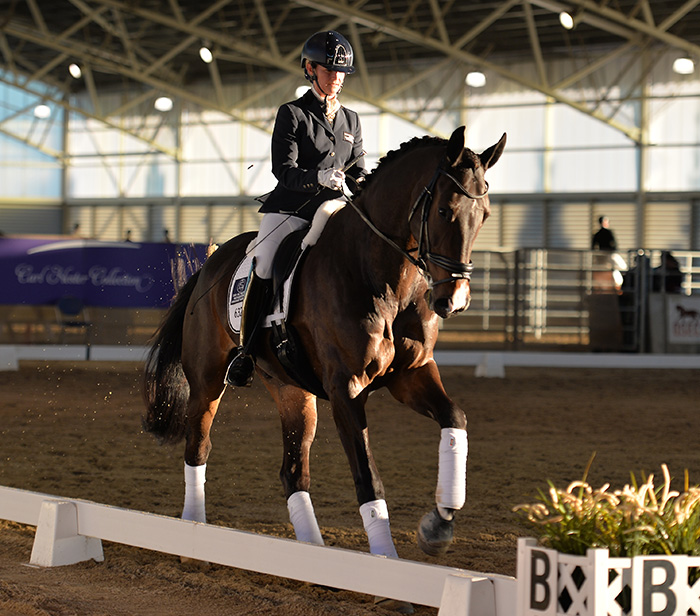
San Fama and Emma Flavelle-Watts
“Why is the canter so important? If your ambition is Grand Prix, look at the judges’ sheet and see how many canter movements there are. The other paces are important, but canter is the most important.”
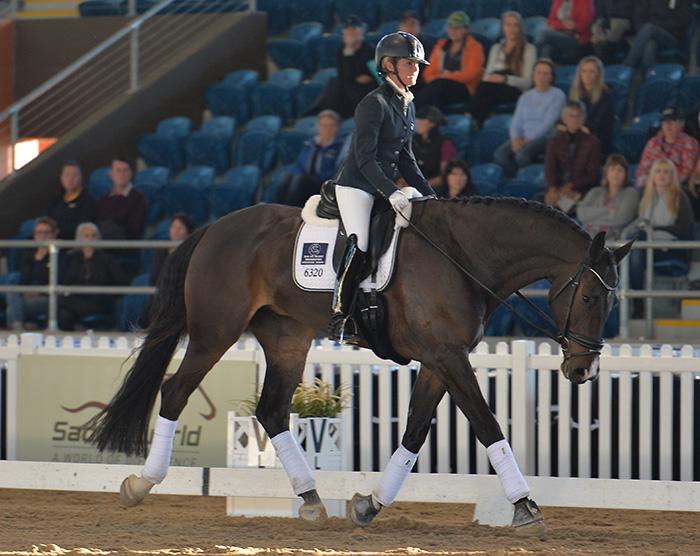
San Fama and Emma Flavelle-Watts
And the horses were not going to be allowed to leave the arena until they really let go and stretched: “The main thing is to leave the arena relaxed, you can only finish when the horse is relaxed, if it is tense, then keep going until they will relax.”
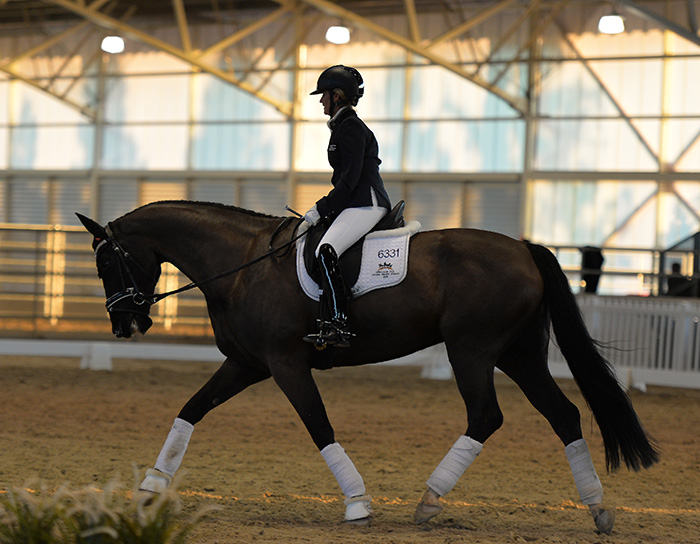
Remi Downunder and Hope Beerling
Time for us to relax, enjoy some of the local Barramundi and a glass or two of wine, all the better to enjoy the master class the next day.
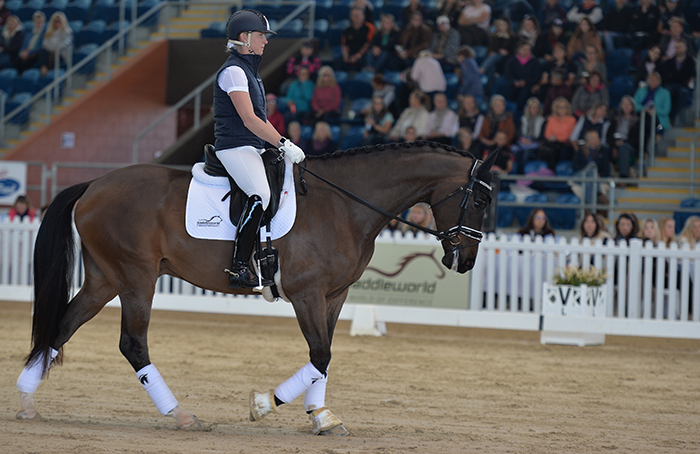
I understand that the local hero, country singer, Keith Urban is the only person who can actually fill the huge indoor arena, and it seems that Carl’s drawing power is only slightly less than Urban’s, it is the closest thing to a full house I’ve seen at a horse event at Caboolture.
Carl is stressing to his student, Tori Welch riding her four-year-old De Lorenzo K (De Niro / Sandreo / Metall) that the Young Horse class is really not the be all and end all. “Many of our Grand Prix horses were not Young Horse stars, and plenty of Young Horse stars disappear. I’d rather a normal moving horse with a fabulous work ethic, than the super mover.”
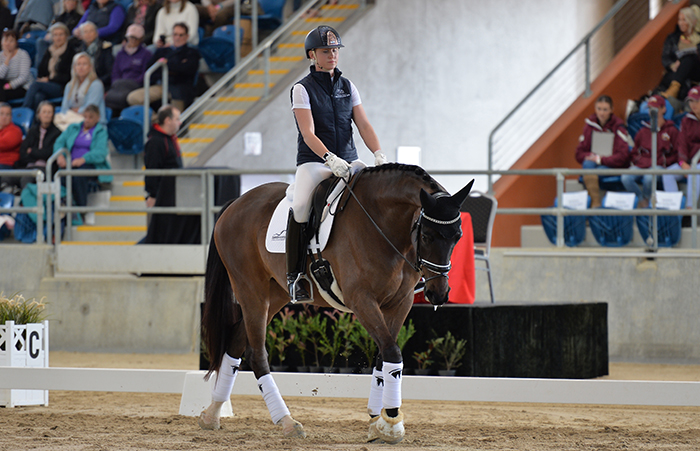
But there are some things Carl is not prepared to tolerate, and that is a lateral walk. “We have a dog at home with an awful walk, and at our open days, I use him to demonstrate – if your horse walks like this, get rid of it, it’s okay for a dog, not for a horse. Tori’s horse hasn’t got the slightest sign of a lateral walk. 9 / 10? Not yet, because he hasn’t got the biggest over track. The use of the head and neck is so important in walk, it should be like a rowing motion, the horse has to take your hand forward and not fiddle and get behind the vertical. Practice a lot of correct walk at home and get him used to being ridden forward in walk.”
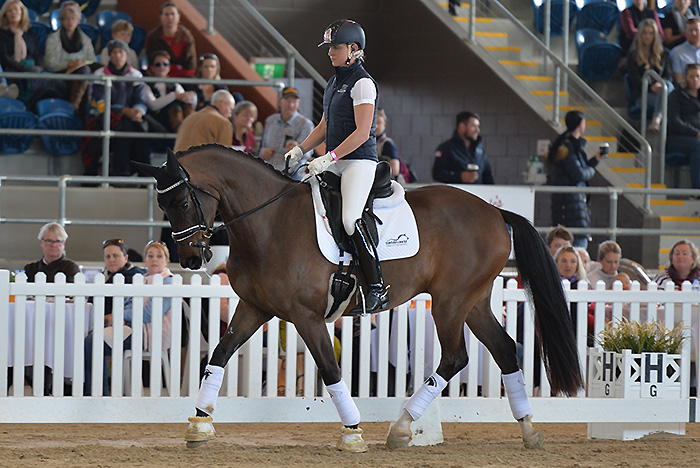
“The trot is the least important pace. I don’t want an enormous mover, just a nice, easy rhythm.”
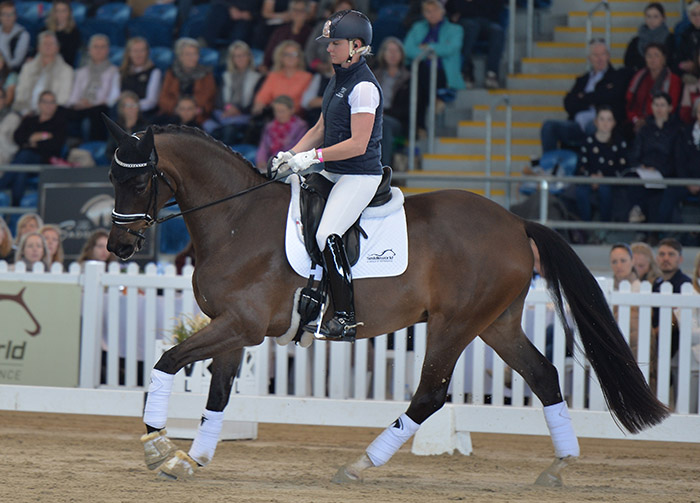
To keep the canter rhythm, Carl warned against going too deep in the corners with a young horse, and once again, stressed the importance of the inside leg:
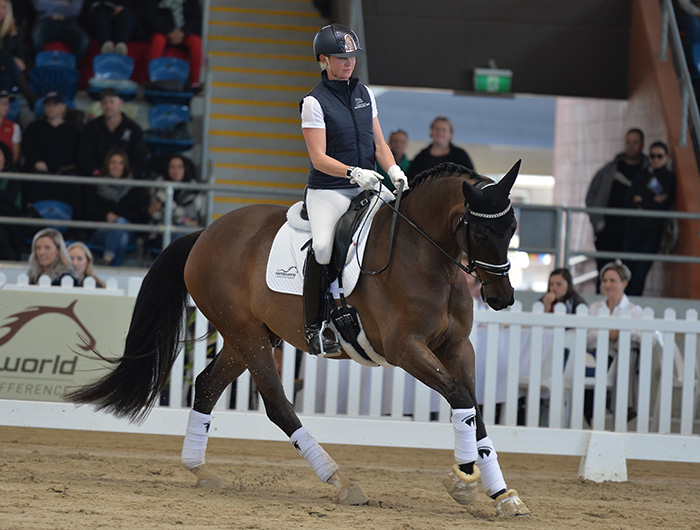
“Canter big half circles in the corners to keep the rhythm, but make sure you get the bend. Watching the Grand Prix horses last night, out of six Grand Prix horses, most when they turned right, almost had a left bend. It’s natural with horses because they are stiff on one side. On the left side they are upright, on the right side, they lean into the rider’s leg. Yes, we all know about inside leg to outside rein, but also think about the inside rein and the outside leg.”
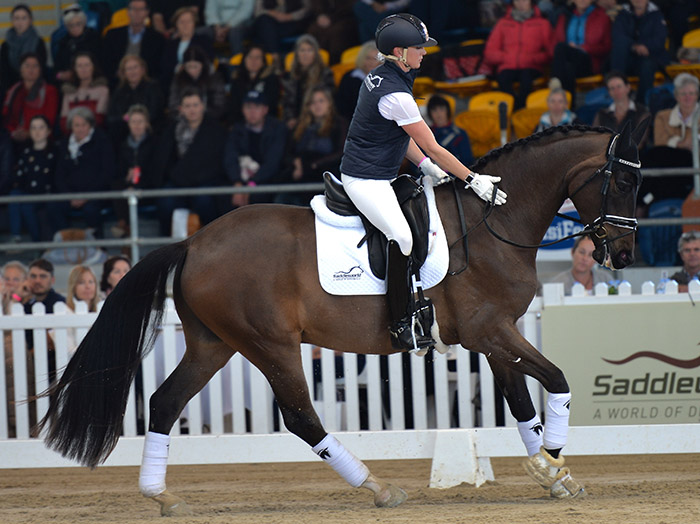
“In the canter / trot transition, try to get the horse to flow onto the bit a little more, so it is more secure in front. You see so many transitions where the horse drops its back and its head comes up. Why? Not enough impulsion. Try not to slow down for the transition, and ride it in a slightly lighter seat.”
“Think of the first stride of canter like the third or fourth stride… In the canter stretch your bottom half and lift your top half, your hips swing through to your hands, not side to side, forward to your hand.”
“This horse is almost too light. Some are born with mouths like silk, some with mouths like bricks. The heavier horse is easier because the light one is often behind the bit. The one that is behind the bit will never collect. You need a very good still hand for the horse that is light, he must learn to trust your hand and then he can improve quite easily.”
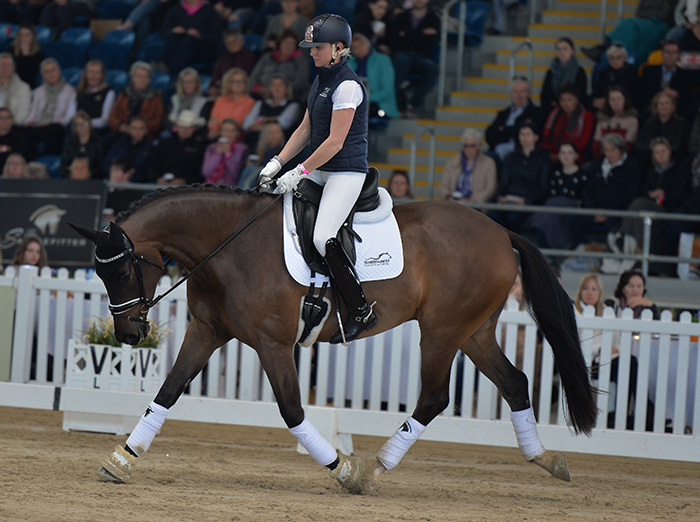
“Charlotte and I like hot sensitive horses but they must have a work ethic, this horse has a 100% work ethic. With age and getting stronger, he is going to show lots of improvement. I picked all these horses off a video, and you don’t really know what you are getting. If they turn out to be very difficult, then it can be a nightmare for me, great for the spectators. Tori’s horse is just perfect.”
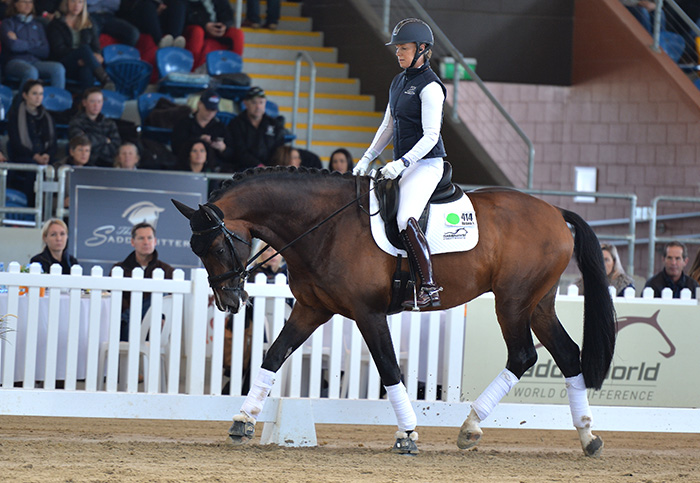
The next horse into the arena was the imported, Dutch stallion, Iresias L (Johnson / Ferro). The horse won the Australian 4-year-old title last year, and followed it up with a win in the 5-year-olds this year. Gina was, before she saw the light, a star in the Hack Ring. Carl says that Charlotte, who comes from a similar disadvantaged background, believes that the most difficult thing to change was the fixed outline, the fixed arms, and learn to ride the horse to the bit.
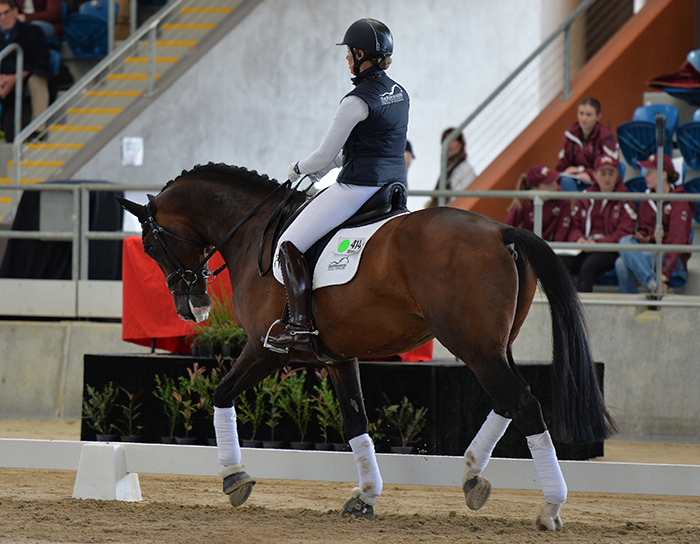
“We want the horse in self carriage, and that means the rider has to be in self carriage and without a strong core, that is very difficult to do. It is worth spending the time getting your core strong, then you won’t need your arms or legs to hold you in the saddle – they must be soft and independent of your body. You must work to get better, Charlotte goes four mornings a week to the gym, then comes home and rides ten horses a day. There’s lots you can do to improve your riding.”
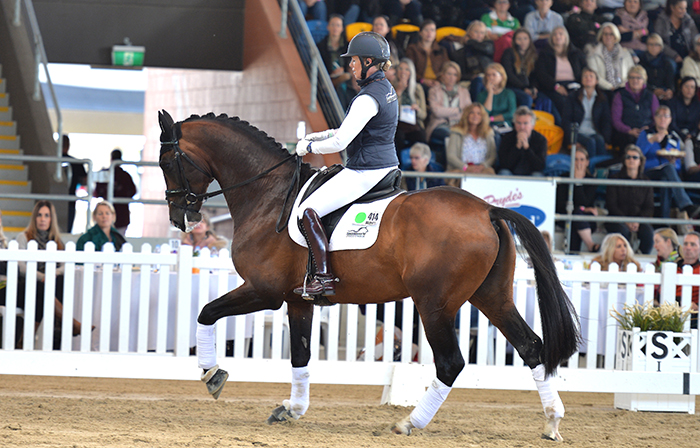
“Looking at this stallion, you cannot help but be drawn to his hind legs. The judges love hind legs like this, that are very natural. It’s typical of Johnson.”
“Utopia was brilliant as a stallion with his temperament and focus. Stallions can struggle with tension, or some go dead. I used to think mares were difficult, but they are not, stallions are. Now half our yard is mares, and half geldings.”
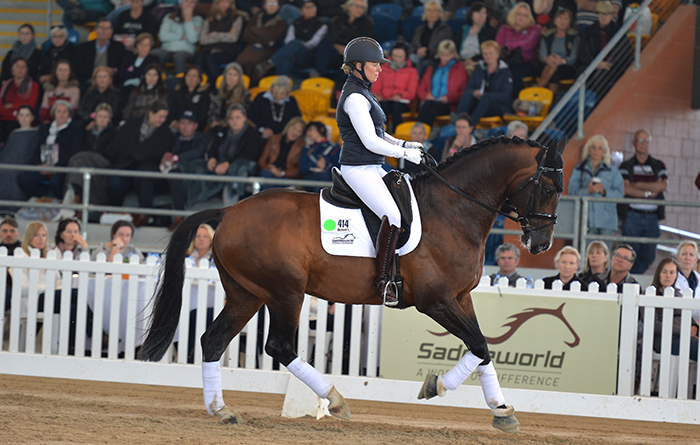
“I don’t want Gina to go more forward, I want the horse to go more to the bridle. Make the half halts to the ears and open the horse’s neck – don’t close his neck. Ride forward, but ride his neck up so the long steps stay in balance. Always keep the bend in your elbow, don’t flatten your arm or you will flatten his neck.”
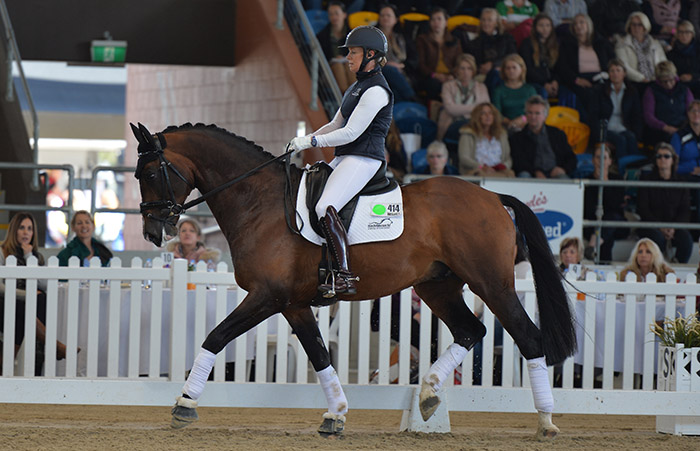
“When Gina pushes with her leg and slows him, he gets heavy. I’m trying to stop that. Bring the horse back by bringing your upper body up, let your leg go forward, upper body back and look through the ears. When Gina’s half halt lasts too long, there is a little wrinkle (in the skin) in front of the saddle. The half halt should be for one stride, more than that and it shortens the neck.”
‘Johnny’ has a lovely canter, just like his dad: “The canter has an easy balance and quite nice use of the hind end – sit him up a bit and release the shoulders. I want to see the plait behind his ears, not the plait third from the top. Right now I don’t mind if he comes too high, it teaches him how to use his shoulders.”
“In the corners ask for half halts riding forward, and relax your body going out. If you feel the horse goes quicker when I say ‘go’, he has to come back again.”
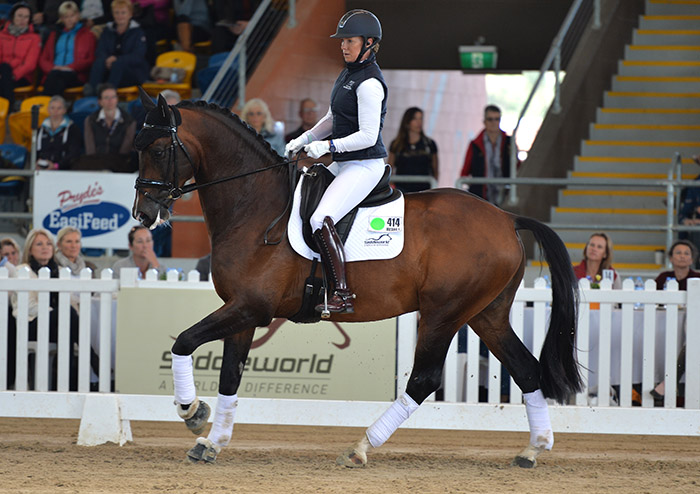
“You know there is a lot in that horse, but don’t ask for that – ride the balance and the half halts. Do a lot of forward and back so the horse comes in front of your legs and starts motivating himself, then you will feel the energy coming out of your hand. The horse can only respond to a half halt if it is followed by release.”
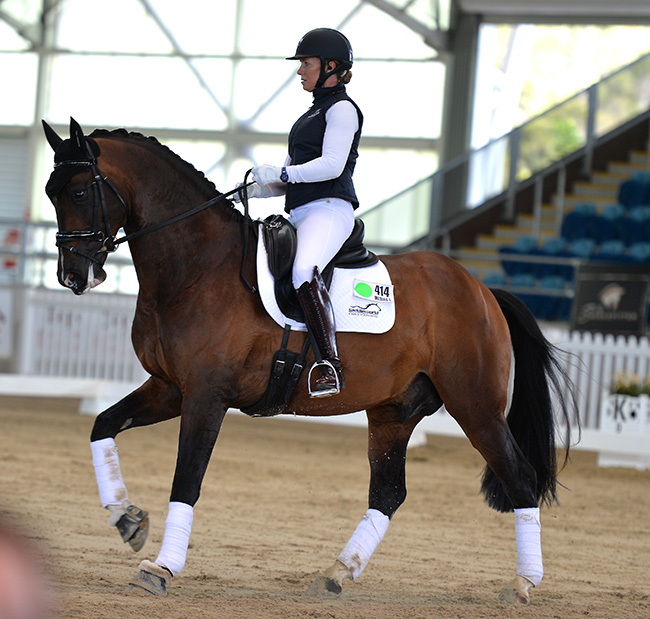
It’s the sort of commentary that you can only get from someone who has done it themselves, but you can see little adjustments making a big difference.
“Don’t let the horse become buried, use the corners to get him uphill. Give the feeling of leg yielding from the outside, that’s really good when the horse falls out through the shoulder. Don’t sit against the bit, hands forward. Keep him under you, keep your upper body straight – not sitting back with your legs forward. If the horse pushes down on the bit, upwards half halt.”
And the rider was not immune:
“Gina NO nodding, that’s stiffness in your back, keep your head still.”
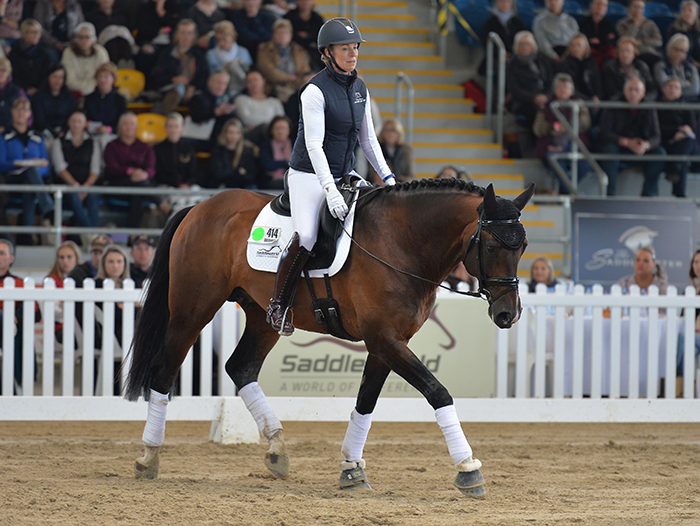
Stretchy time again: “Common sense tells us that if something needs to be supple, it can’t be in the same position all the time. Stretch the horse… Suppleness and stretching take years to get.”
more follows
The next student was Danielle Keogh and her imported six-year-old mare, Federation (Fiorano / Hochadel). Carl points out just how much more difficult the six year old test is – “Half passes, shoulder in and flying chances, and even with a professional, training flying changes with a six-year-old is a tough ask.”
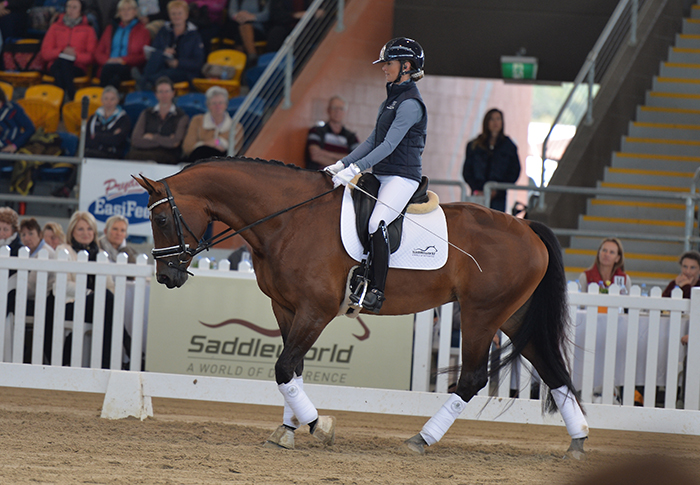
He also confronts the dire issue of which leg – rider’s that is – gives the aid for the canter depart: “I think the outside leg gives the aid. I’ve never met anyone who can explain changes from the inside leg, I just don’t get it.”
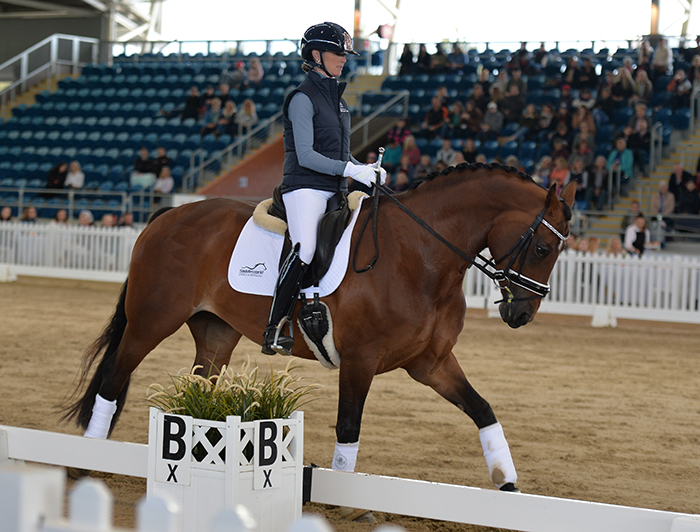
“This horse is cantering with a low neck, pulling down in the transition. Shorten the rein and bend your elbow, let’s see her sitting ability.”
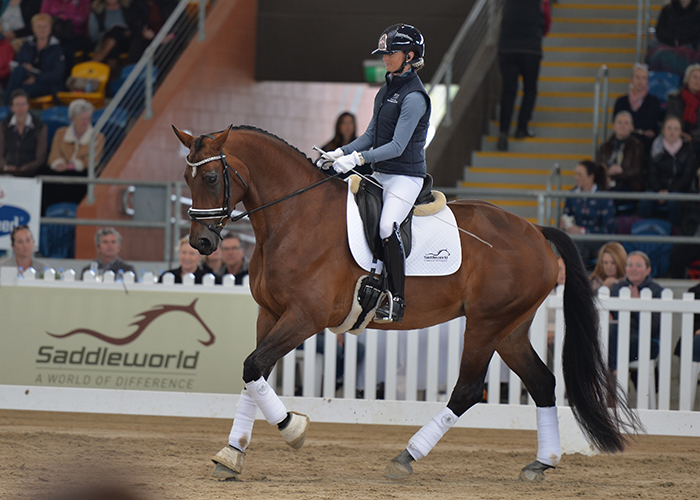
And the downward transition was equally important: “When you ride the downwards transition, ride it forward, otherwise the hind legs come down together instead of being separated and ready to step forward. Do not do it if the feeling is not right – but if the horse is trying to do it, don’t say ‘no’ or they get very tense.”
Really the minute you see a rider’s upper body behind the vertical you know something is wrong, very wrong, and Carl was having none of it in his Master Class: “NOT upper body back and leg forward, heel under hip.”
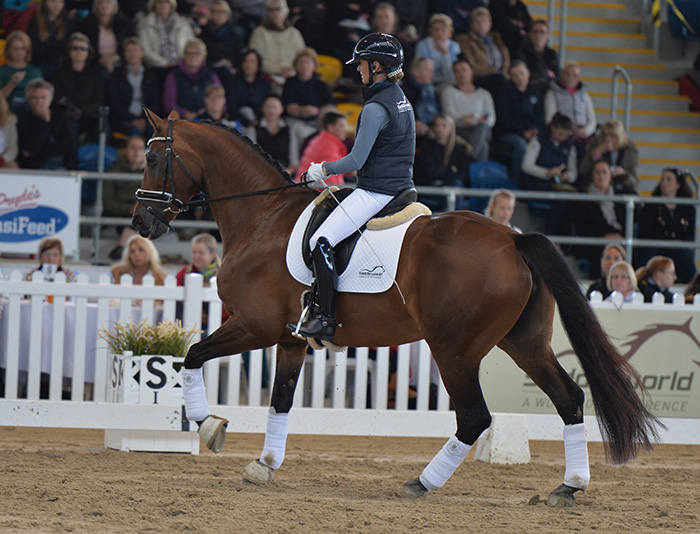
“Touch with the whip, touch with the whip, when you get the horse quicker behind, it is a much better half halt. The horse should not be afraid of the whip, but it should not be too friendly to the whip. You need to get a reaction, it’s no good if they are dead to the whip.”
Carl had an absolutely brilliant exercise for the horse that gets hotter as it comes up the centre line: “Walk a little zig zag line, that will get the horse on your legs, then you can ride forward and not be left behind. Check your hand all the time – not over the front of the saddle. And you are not a fairy on a tree, use your leg and ride the horse positively. This horse rides you, it gets tense and you go away.”
“See there, when you got positive, it gave the horse confidence. I like this sort of horse, the tense comes from a want-to-do it.”
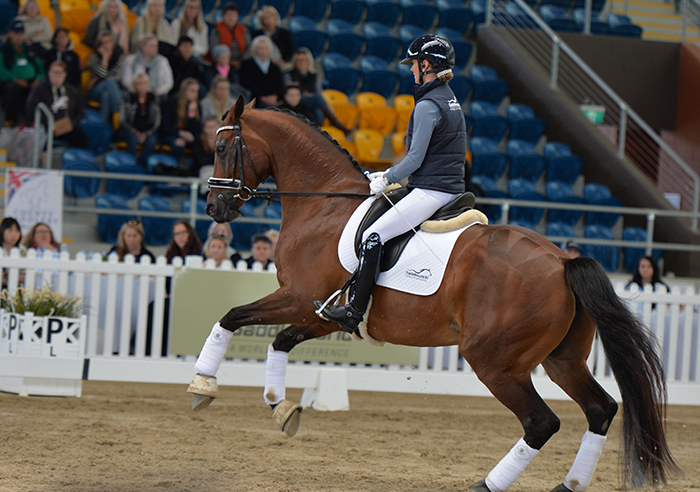
But Carl was setting the standard high: “Do you think Charlotte Dujardin or Isabell Werth would accept a change like that?
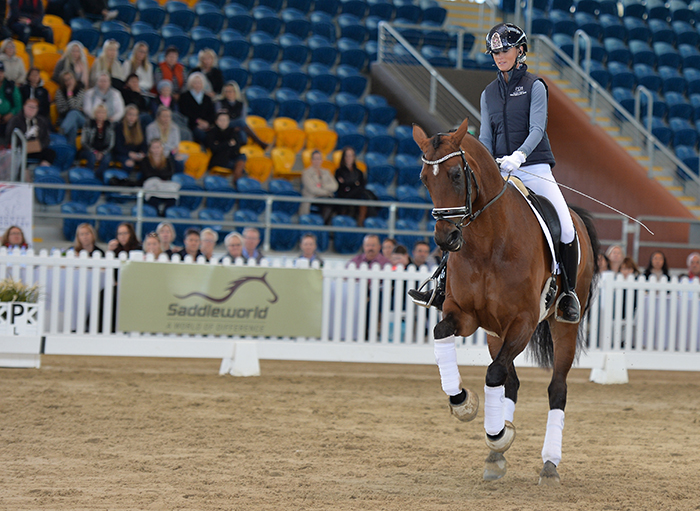
Do it again, the horse learns by repetition not by getting away with it.”
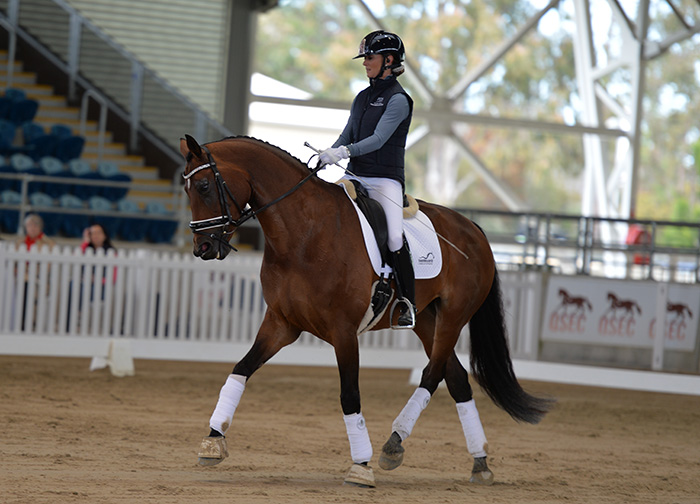
Time for the half passes: “A young horse needs to half pass in a slightly travers position, with the hindquarters trailing slightly – not quarters leading. If you make it too parallel and too difficult, the horse will lose rhythm.”
“Okay go on a circle rising trot. Use rising to help the horse with the rhythm – change the diagonal to the inside, that helps. You should mix up sitting and rising trot more.”
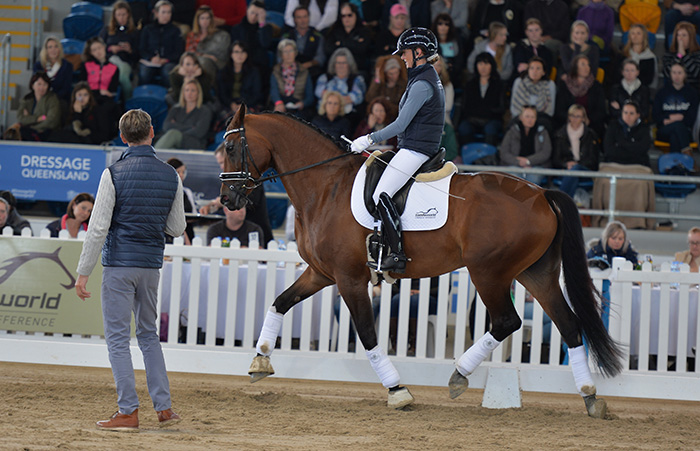
Always encouraging: “It is nicer to be like you, a little more passive than aggressive, but you need to be more positive.”
more follows
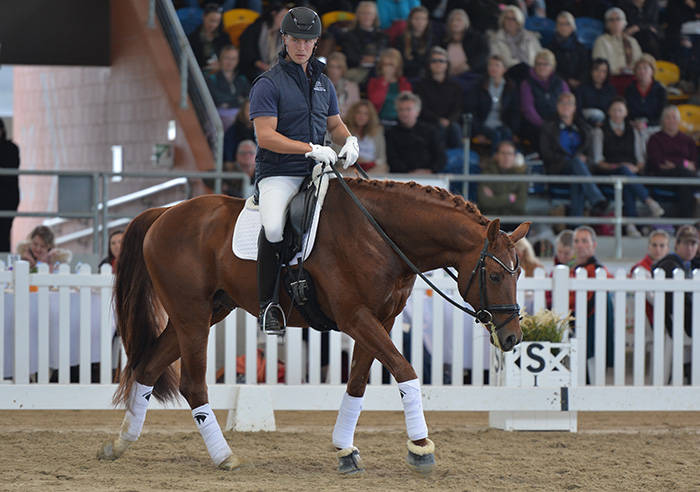
The next horse, ridden by Elliot Patterson, is another import, the eight-year-old stallion Bluefields Berlin. Carl is stressing just how difficult it is to get to Grand Prix:
“We have tens of thousands of dressage riders in the UK, out of that we have only 50 Grand Prix horses, and ten of those would be international standard.”
He also stressed that it was not easy to pick which horses would make the cut: “Eight is a great age to assess a horse. Sometimes you look at them when they are six and you think they are too lazy, not good enough to make it, but they come good when they are eight. This horse has three lovely paces and he has presence.”
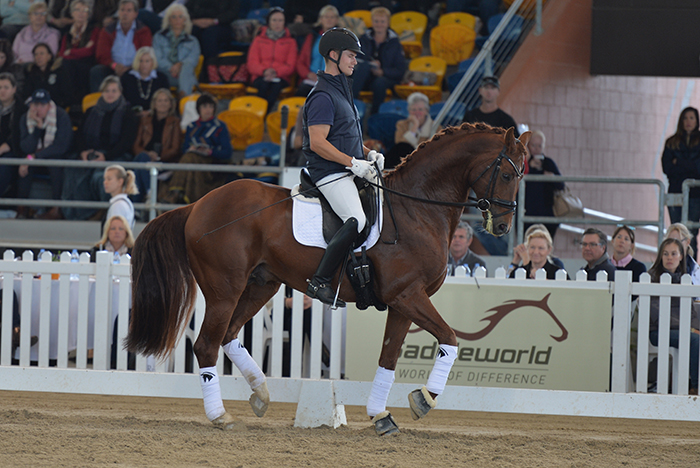
“If I have any criticism of Australian riders, it is the length of rein, you tend to have your hands too far back.”
Carl is discussing the difference between Grand Prix passage and Young Horse passage: “You need to be going forward into passage, not coming back. The horse should think about trot in the passage instead of slow passage. Forward passage, go rising and help him come up in the middle. He’s thinking about piaffe and coming back, not thinking of pushing forwards, they must push to passage, and he is only going to learn pushing from the trot.”
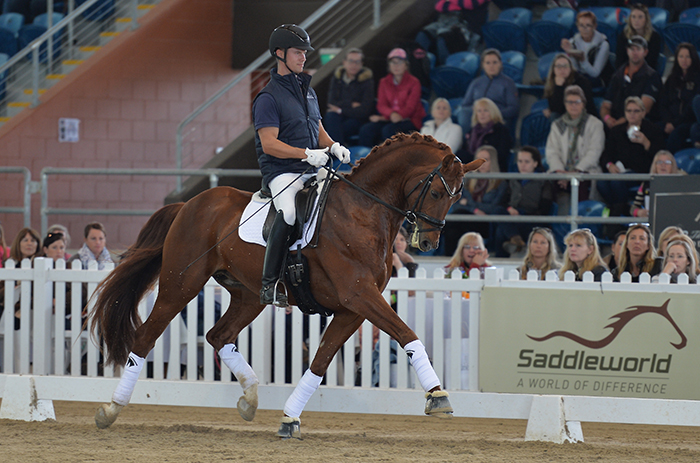
“Go into medium, touch him with the whip, keep the contact and ask for passage. Poor horses, we are always in their back, slow down, they get weak in the back and start to sway. Rising in passage, lots of riders do it, but you don’t see it in books. This horse is like a little rubber ball, he has such good spring.”
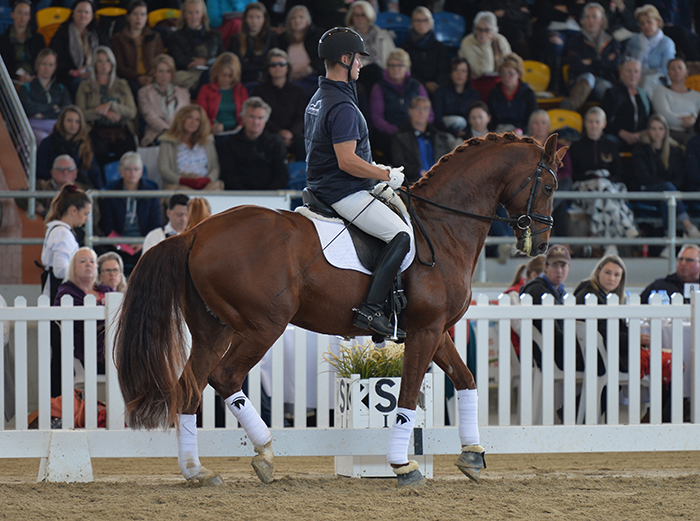
Now piaffe:
“It is important to walk into piaffe and walk out. Teach the horse the mechanics of piaffe, coming down behind, not croup high. In piaffe it is good to think of sitting over your knee so the seat is light.”
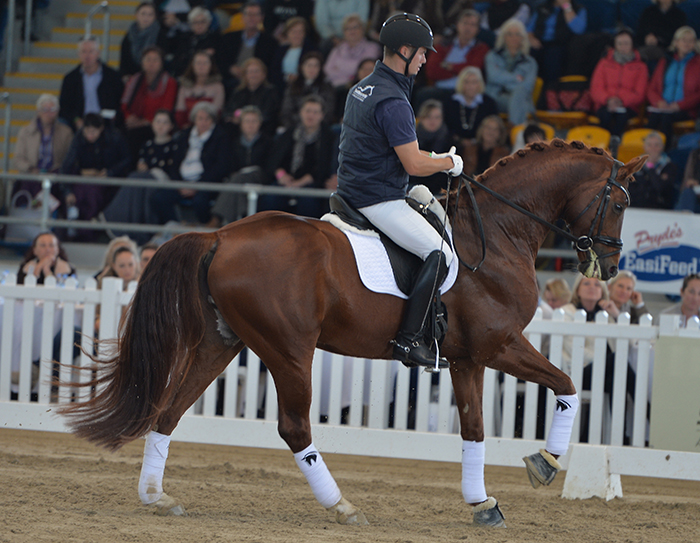
Carl was making the canter work tricky: “When you are doing short canter, I want to think I can walk beside you, that short. This horse is a bit spikey in canter, let him sink to the floor and stretch. You push down with your seat and he goes hollow, think of sitting over the knee.”
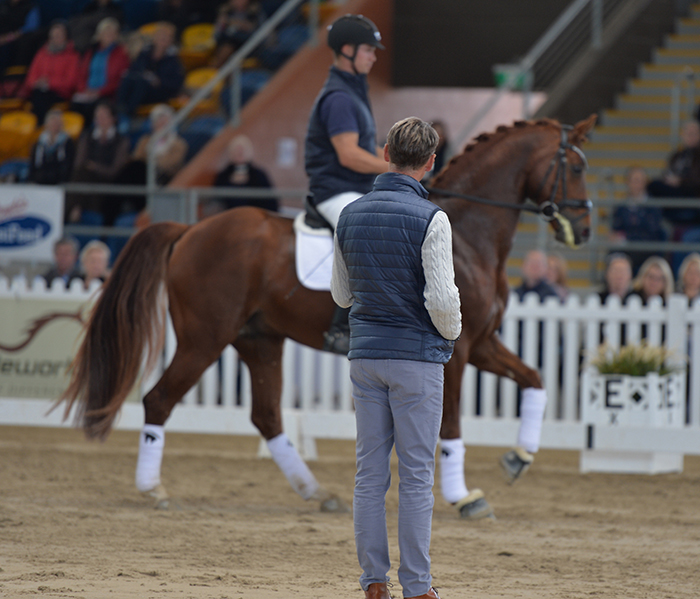
“In the half pass, focus on the letter, looking through his ears, you are going right and looking left. Look at his ears, if the inside ear is down, he is crooked. I don’t want the half pass tighter, I want it forward and looser.”
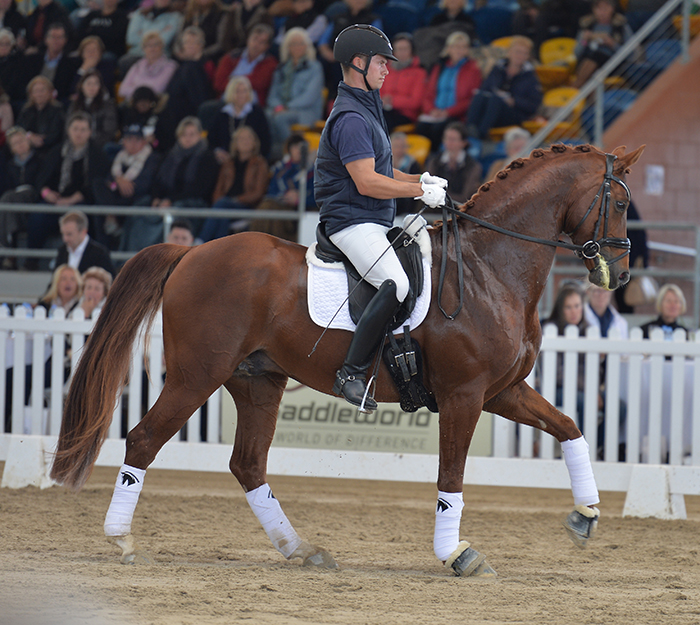
And never get stuck in a rut:
“There are two types of seat, active and passive. Don’t ride hard all the time: active, passive, active. The main thing is to think about the horse’s back a lot.”
“Remember we turn the horse from the outside. There was a jockey back home, and he was going to ride a dressage horse for a charity event. He asked me for one session to get ready. What do you want to do? ‘Flying change, piaffe, passage.’ So I put him on a Grand Prix horse, and he started to canter around the school. Okay, go across the diagonal. He took the inside rein and the horse’s head was on his knee, but he never left the track. It had never occurred to him that you rode the horse on the outside, but after twenty minutes he learnt to turn the horse – and do a change.”
Canter pirouette time:
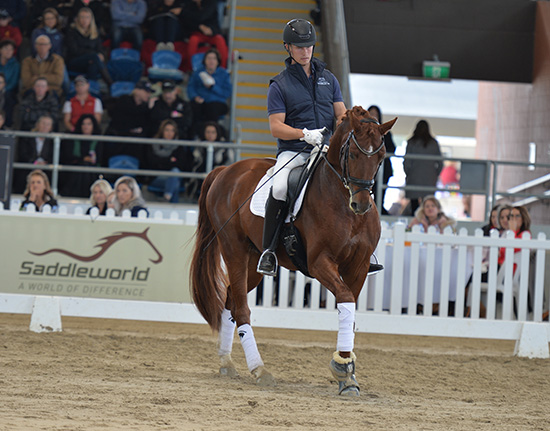
“This horse has the two ingredients of pirouette, it can canter short, and go sideways. There is an 82-year-old lady who lives in my village, who trained with Robert Hall, and she comes and watches us work, and she won’t let you go short into pirouette. This is still a young horse so we need to find exercises that will make it easy for him. Ten metre circle, shoulder in / travers, supple the horse. Think about lengthening not getting the neck up, and over-sitting in the canter. If he learns the pirouette at this slightly higher tempo, then when he does it in the test he thinks forward. We can shorten him without tension in his neck, or in his mouth.”
“It is such fun to ride a horse like this that is so willing. I think he’ll make a very nice Grand Prix horse, the rest is up to Elliot, but you won’t get it if you lean back like a rag doll.”
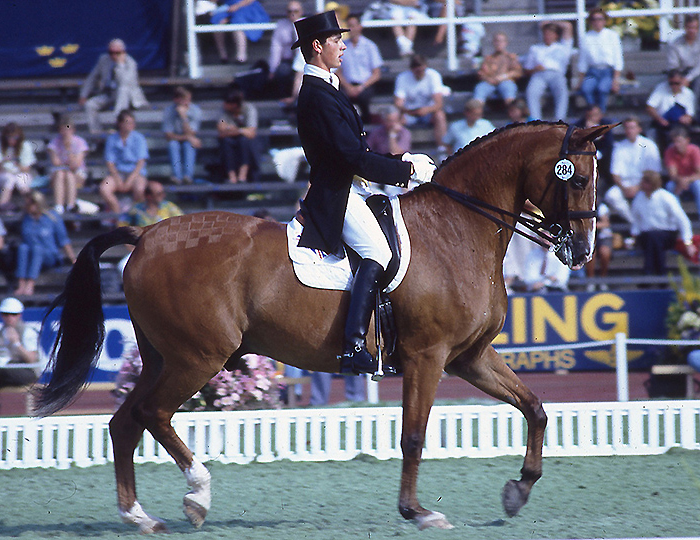
Carl at the first WEG in Stockholm in 1990 riding the Bechtolsheimer’s Rubelit
“I was lucky, Dr Bechtolsheimer gave me the opportunity to ride schooled horses early in my career, but to become horsemen, we need to be able to train our own horses, but it is not easy. It is so difficult, even if you know what you are doing. To get them to Grand Prix at the age of nine or ten is ideal. Then it is a matter of keeping them sound, and that is more about their mind. People asked, why did you retire Valegro when he was only 15 – he’d done enough, he’d traveled the world for six years, winning Gold, and traveling is a big part of tiring out horses. He could have gone on, but he had done enough. The horses Charlotte and I have for the WEG in Tryon have stayed home in the run up.”
“You can’t school a horse every day or you will wear it out, physically or mentally. Train things, play with things, that you don’t do in the Grand Prix. Some horses need to know where they are going, some need surprises. We hid the Grand Prix test from Valegro up to his first Grand Prix, but he looked uncomfortable at his first test, so from then on we did teach the Grand Prix, he needed to know where he was going. Nip Tuck was the reverse, he needed to be surprised.”
More follows
Want to breed to a top European stallion in Australia? You can, go to www.ihb.com.au
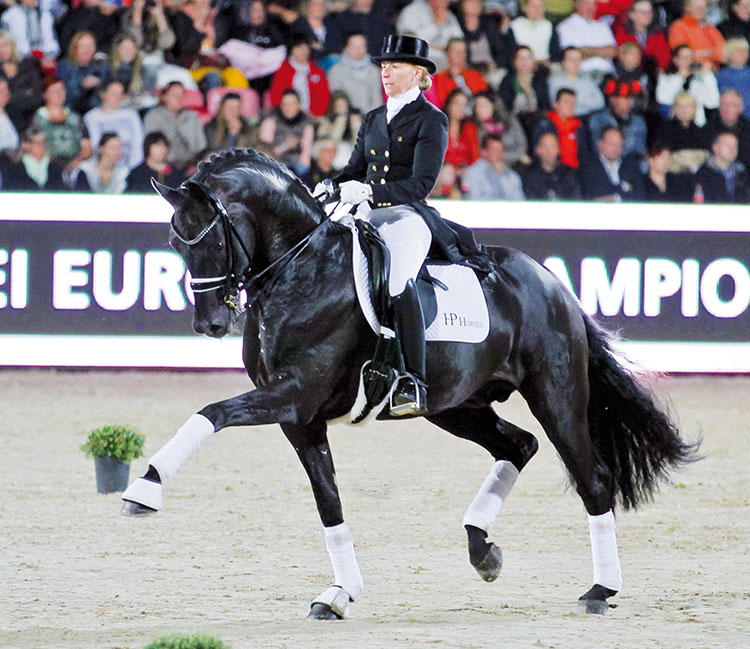
Fürstenball
The next combination was the horse and rider who scored the highest mark in the Australian nominated selection events for Tryon – Aristede and Shannan Goodwin. So they are on their way to the WEG? Well no, she was pushed out of the team by Kristy Oatley, who only competed at one selection event, and whose score at that event was lower than Shannan’s. Wow! Kristy must have starred at the Caen WEG! Well no, Kristy scored 63.771 at the last WEG and was the Australian team discard score. Now Kristy is not responsible for the actions of the Australian selectors, but it is odd that they set up a detailed selection procedure, then when it comes to naming the team, ignore it.
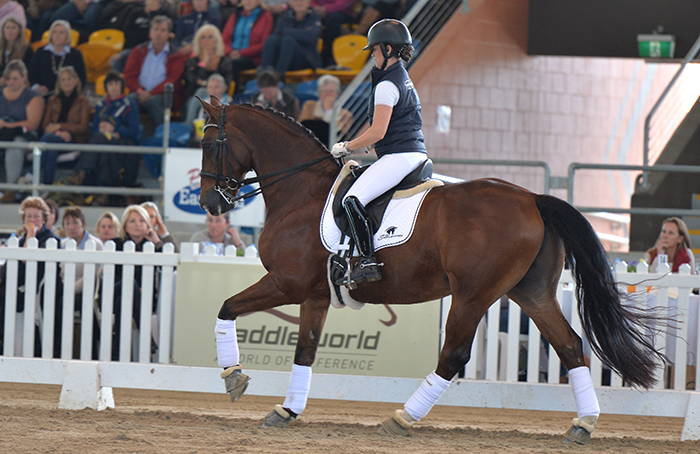
Carl was concentrating on the flying changes with Shannan. “Ride the two times along the track, use the wall to get the horse straight, let the horse work it out.”
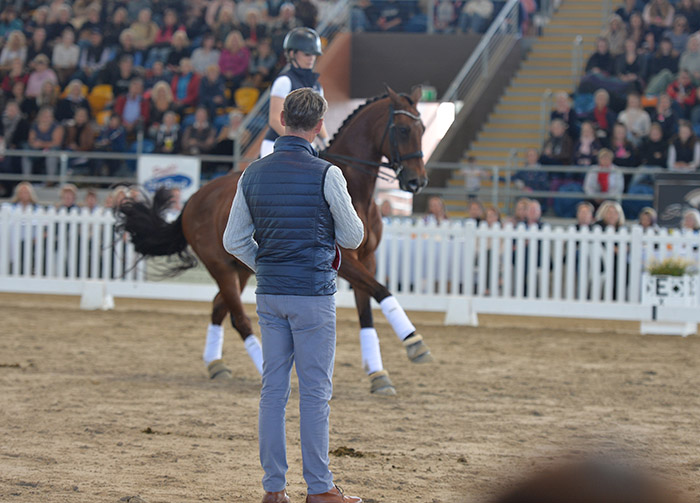
“I was recently at a Judges Seminar and there was discussion of how to score a 9 / 10 for a change, and the opinion was that the rider had to take a risk. Shannan you are sticking to changes that are neat and tidy, let’s try for a 7 / 8 change. You get the horse forward immediately but it takes a long time to bring him back. Your half halts need to be quicker, connect to the lower leg so he goes through with the changes. Out and back, make the back quicker.”
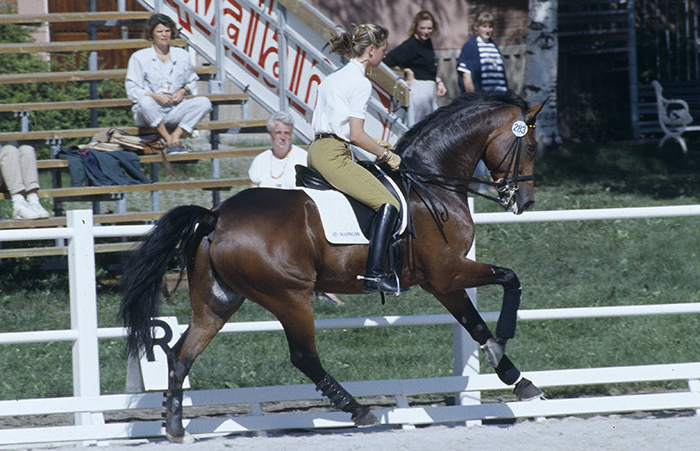
Nicole Uphoff and Rembrandt at Stockholm, working with Harry Boldt before taking Gold
“I remember Nicole Uphoff, she could gallop Rembrandt from one end of the arena to the other, and in one stride she was cantering on the spot. Forward is easy, back and still forward, not so easy.”
“I want the horse on the spot. Looser in your hand. When you grow up and learn together, both of you get very good at hiding each other’s weaknesses. Take the risk in the twos, cover ground as you go along, hands in front of you, look through the horse’s ears. The riders who score 9s and 10s, use the whole diagonal, the 7s start into the diagonal and finish before the marker.”
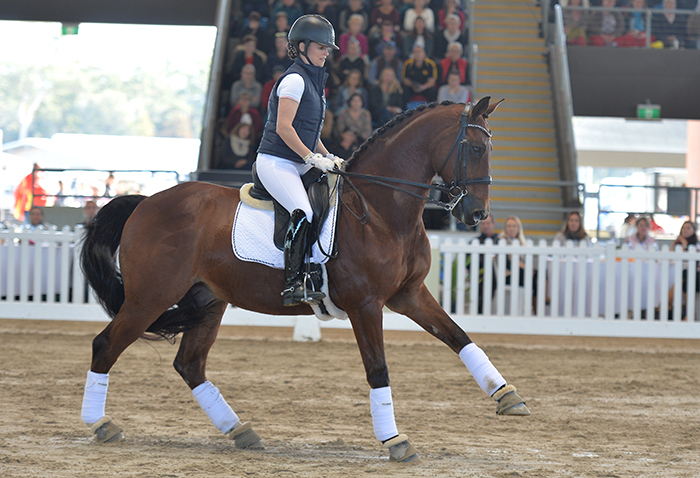
“The Grand Prix comes up so quickly, you’ve got to think ahead. You’ve got to know how many strides your horse takes. How many strides are there on an eight metre circle. She has no idea – you should know the strides because it puts a rhythm in your head.”
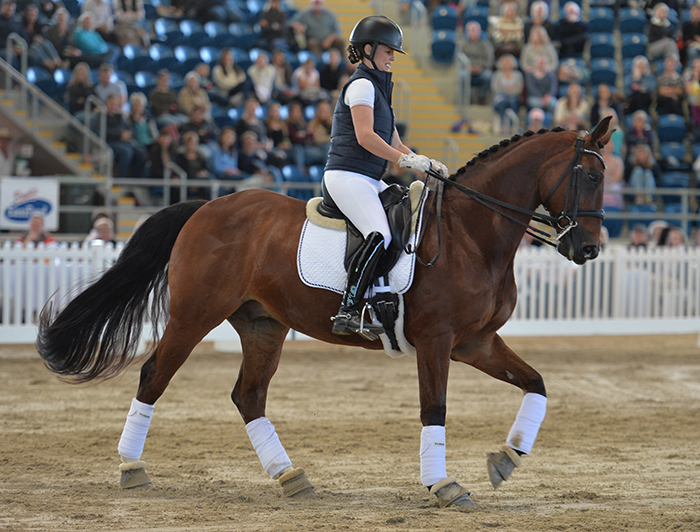
Carl had a great hint for riding the walk:
“Take your feet out of the stirrups then you sit heavier and get a bigger walk. Don’t sit above the horse, sit into him and the horse starts to accept you. You sit down, and your arms move. Now pick up the horse and walk him on the spot. Often the horse gets tense after the diagonal walk, teach him that you pick him up, and he walks on the spot, then forward and let quickness develop.”
Time to try the passage:
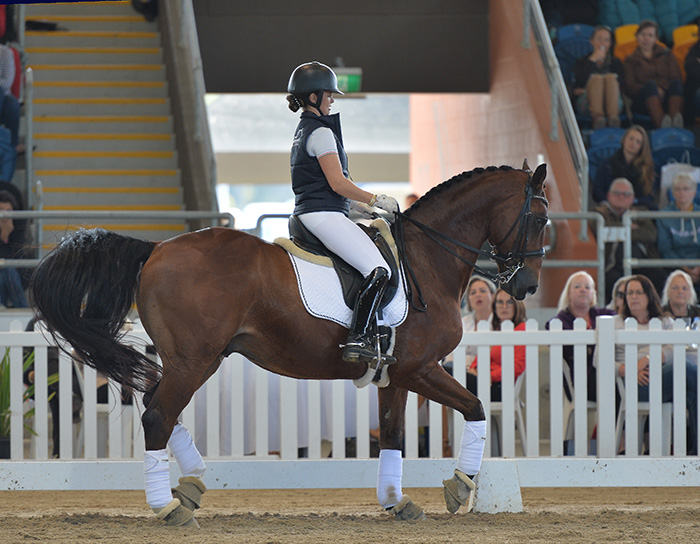
“The main thing for you is stopping the aids, open the knee, keep everything light. When he does a little passage, then his hind legs are under him, when he does a big passage, they have the tendency to get out behind him. Imagine your lower leg is like a little whip. My leg goes forward to the girth in passage, and in piaffe, it comes back.”
Carl addressed the dreaded problem of the horse getting centre line fever at the end of the test: “You see it a lot in competition where the horse gets hot on the centre line. When they come down the line, they see all that space in front of them – leg yield two steps, two steps back, leg yield to the other side, and back. The last thing you want to do is frighten the horse.”
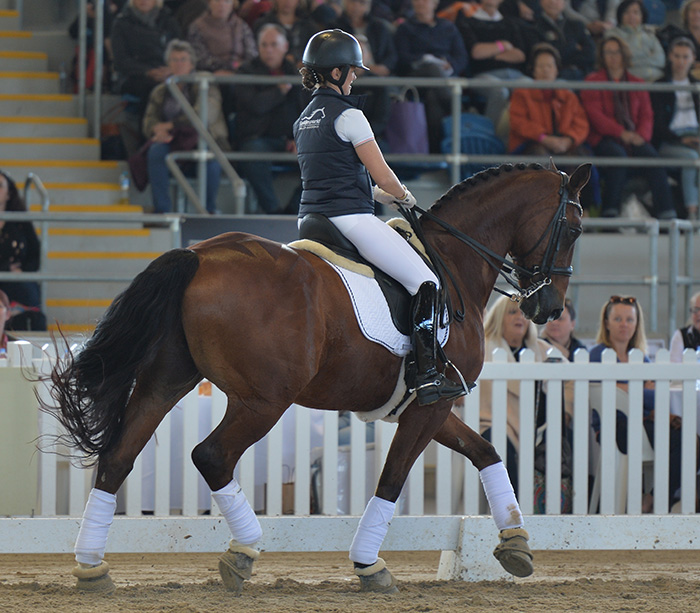
The final advice:
“How do you create a horse that is quicker behind? Think about it, the more you do, the slower he gets.”
more follows
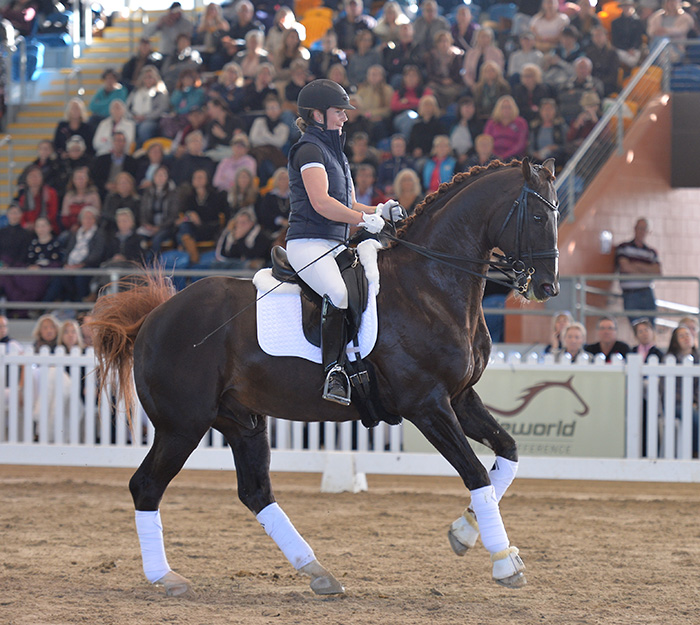
The final combination in Carl’s Master Class, ARE going to Tryon – Alexis Hellyer and the 12-year-old stallion, Bluefields Floreno, and if they go as well as they did at Caboolture, they are going to make us very proud.
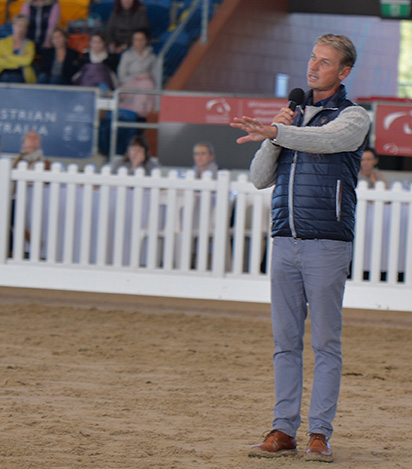
Carl speaks from experience:
“Going to the WEG is a huge opportunity, it is also scarey. Make the most of it, ride like you are at home. Alexis would like to work on her pirouettes, let’s start with straightness. Canter the centre line and see how straight you can get the horse, how much you can collect the horse at the pirouette spots. Ride a little shoulder fore and get the hind legs between the front legs.”
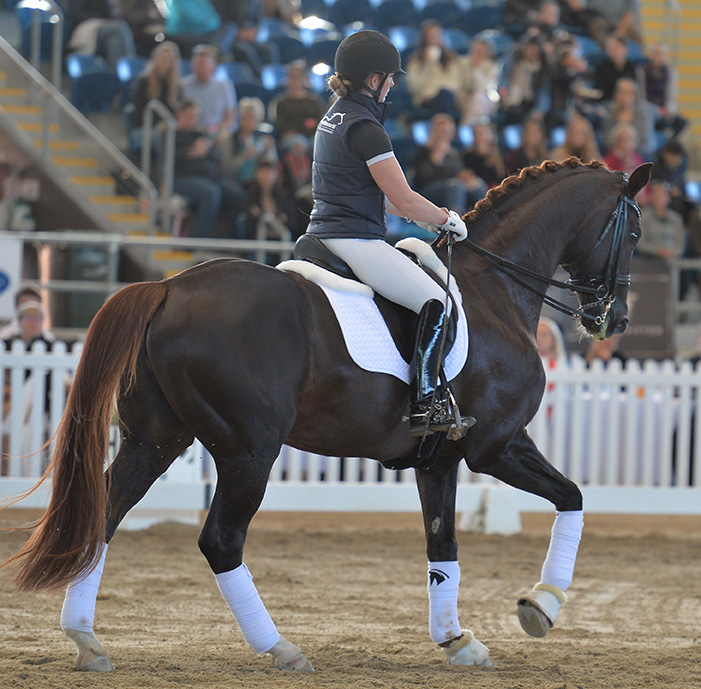
“Do it again, shoulder fore to L, canter on the spot, ride out, do a change. The horse is straight and he collects easily, but the flying change lands on the forehand. Ride up to the flying change, and make sure you are not on the forehand.”
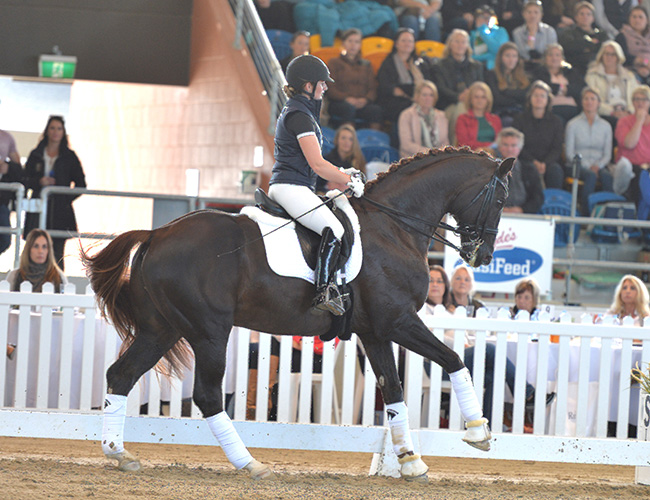
“Try not to look down, look out between the horse’s ears, stretch your core, lower leg down. You need your future husband (Elliott who rode Berlin) to buy you a big diamond earing for your left ear to stop the right one going down.”
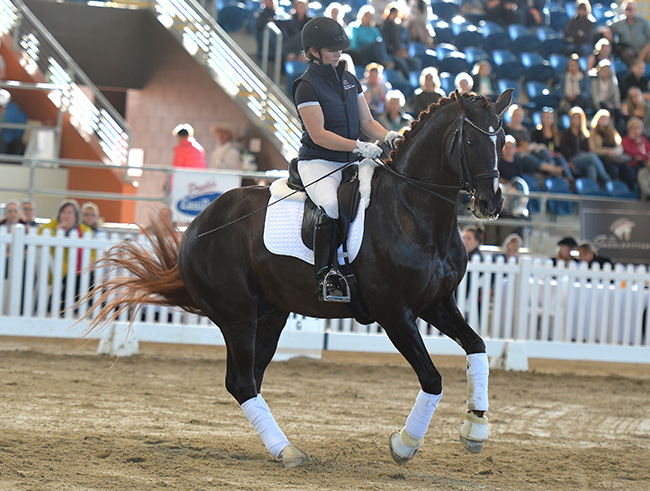
Back to the pirouettes:
“The golden rule for pirouette is start small and get bigger. You start big and get smaller. You lost your canter, be brave, faster canter, bounce to the pirouette. The pirouette has a coefficient of 2 because it is hard. Start small, get big, increasing the impulsion at the end, helps the horse. And canter out.”
Alexis rides a pirouette, and turns right and then goes back walk: “That was silly, the trot comes at that place in the test, not the walk. And when you do walk, make it a slow walk, the quicker it goes, the smaller the over-track. We have a one hoof over-track, he needs time on the floor, he doesn’t need to come off fast – that is better, one and a half over-track.”
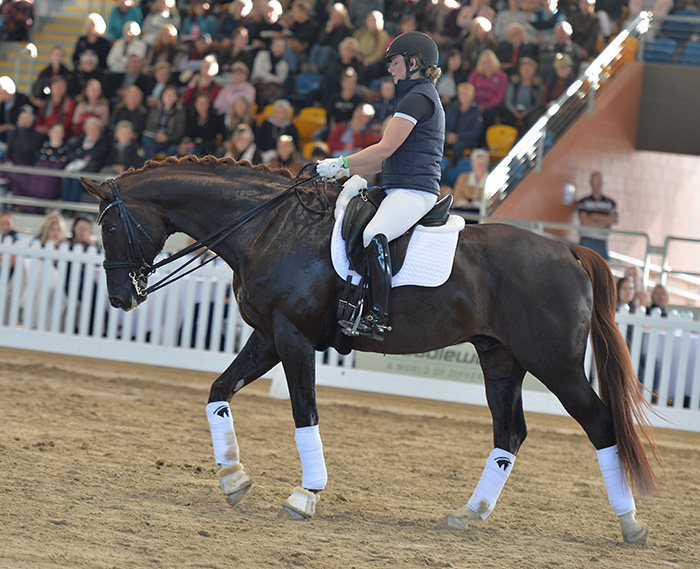
“The hind legs are good, the front legs are too quick, he has to learn to use his shoulder. There, now we are getting closer to two hooves over-track.”
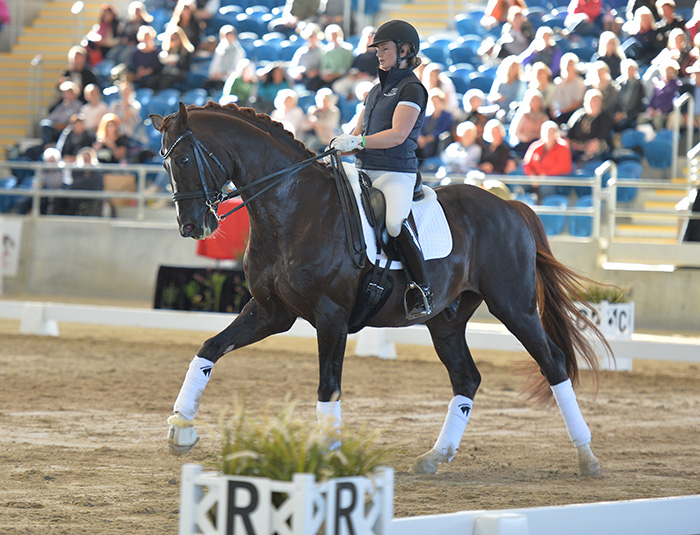
Alexis wanted to work on the canter changes of hand:
“Zig zag in slow motion, you love everything to the right, and nothing to the left. Keep bending left. Pirouettes and zig zags are my hardest things.”
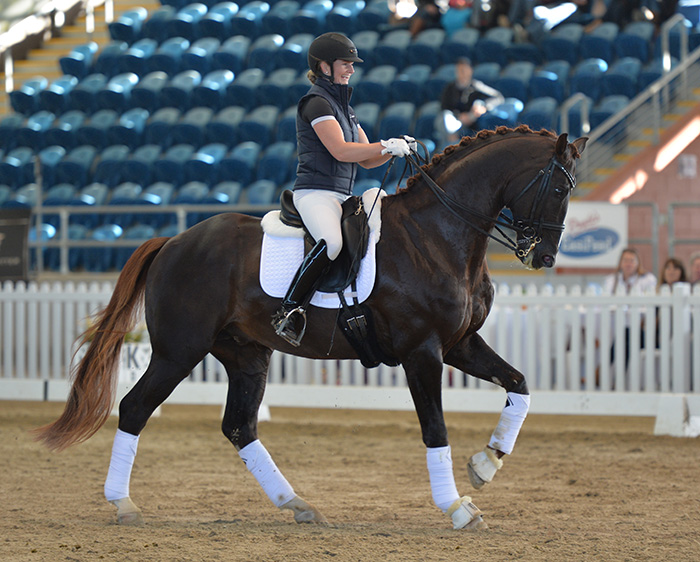
“The biggest mistake is hurrying through the zig zag.”
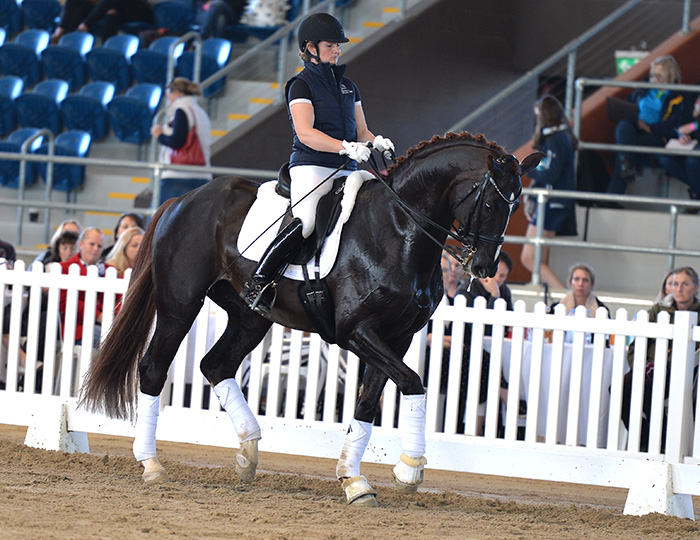
They finish with some piaffe / passage work:
“Don’t sit too light in the passage. Light in the piaffe, down in the passage. The horse likes coming into piaffe better than coming out. He gets a little over the shoulders in the piaffe, help him lift his shoulders in piaffe, and it is easier for him to come out.”
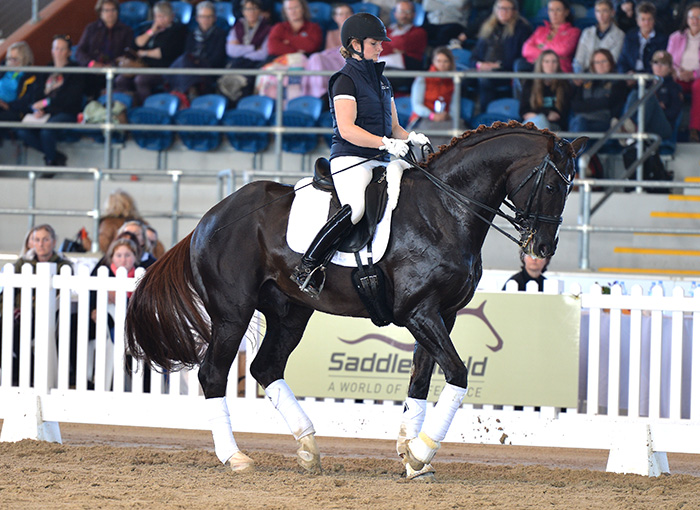
“This horse looks like he is one of the ones that needs to know where he is going. That will help you too.”
Carl finishes with the comment: “This is probably the best bunch of guinea pigs I’ve ever had. Thank to you all for listening – see you in a year or so. I hope.”
And we thank Carl, and look forward to seeing him again!
Congratulations to Leesa Murray and her fantastic team on another great event. Congratulations also to Nicole Tough, Chair of Dressage Queensland, and all who supported the event by volunteering, sponsoring, participating and attending.

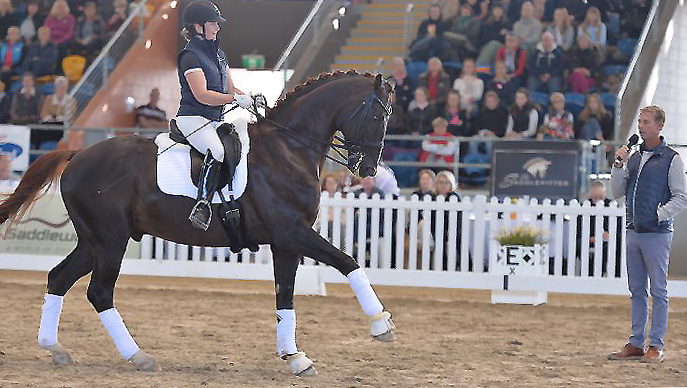
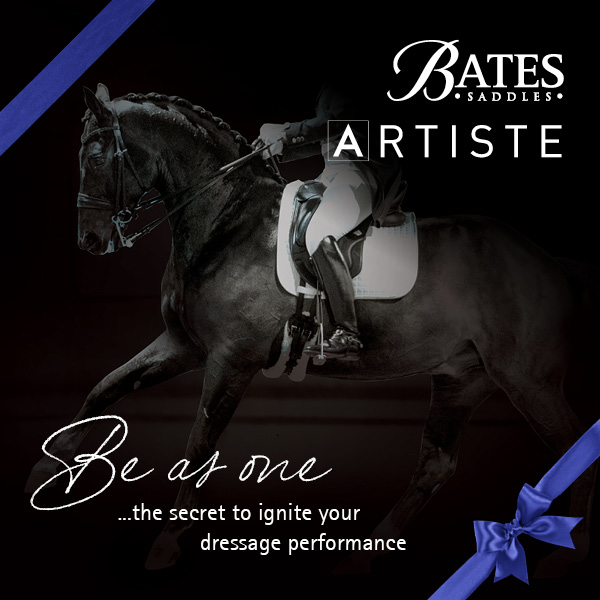
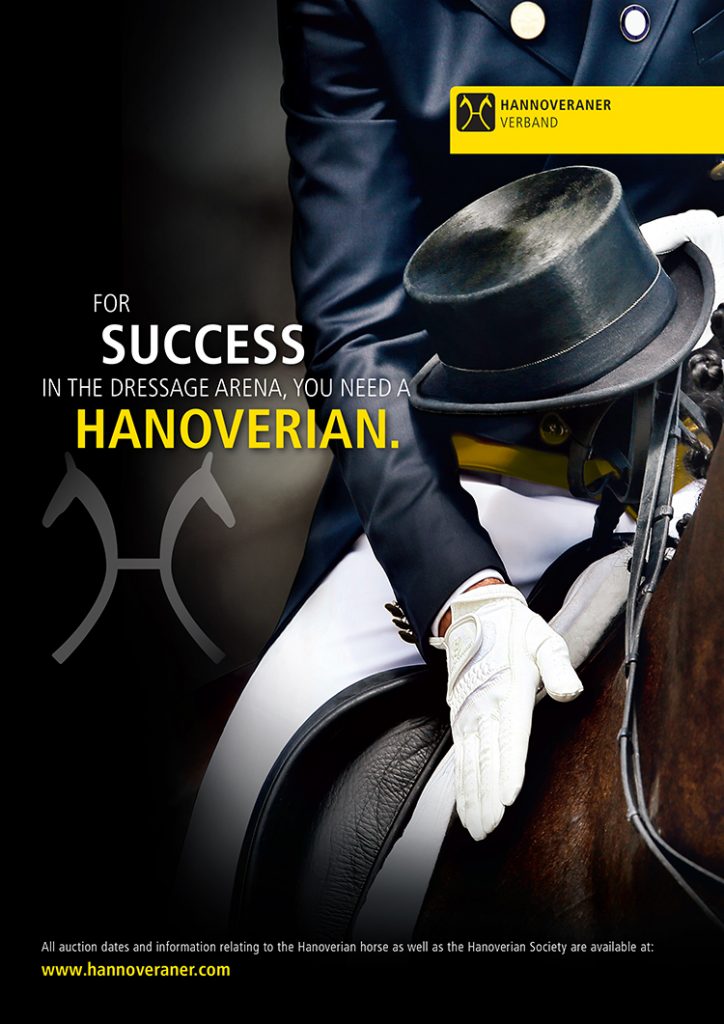
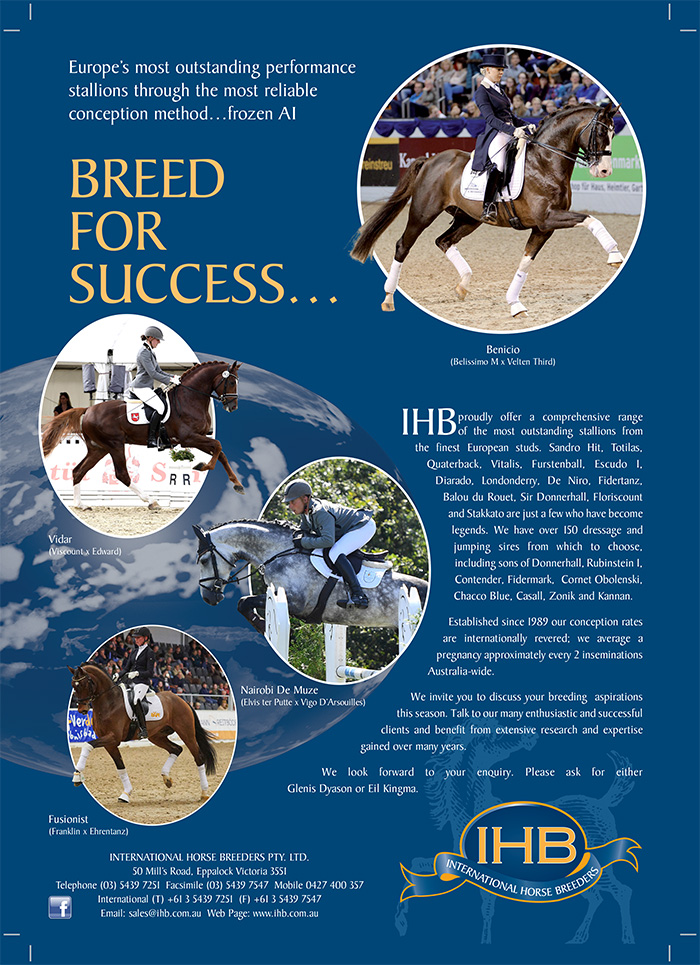
GREAT ARTICLE, CARL IS THE BEST!
Thank you Chris for this article. I am so heartened to hear a young person such as Carl continuing to promote the correct training of the horse.
Megan Joerg.